How To Choose The
Best Travel Backpack
The minimalist's guide to selecting a carry-on backpack for one bag travel.
Fitting your life into one bag is no small task. We’re here to help.
We’ve teamed up with CabinZero to give away a selection of top travel gear! Check it out →
Best Travel Backpacks
Click to learn more about why we love these top picks.
- Aer Travel Pack 3 (Best value)
- Osprey Farpoint 40 (Best budget)
- TOM BIHN Techonaut 30 (Best splurge)
- Cotopaxi Allpa 35L Travel Pack (Best organization)
- Able Carry Max Backpack (Best carry comfort)
See all reviews: Travel Backpacks
What Will This Guide Help You With?
This guide will cover different types of travel backpacks and explain how to choose the best one for your needs. Each section illustrates the following information to help you narrow them down:
- Our Picks: These are the bags we love and recommend to travelers the most. We evaluate each bag on the effectiveness of its features, carry comfort, and carry-on compliance for one-bag travelers. In addition to bags that excel in a specific purpose, such as carry comfort and organization, we also include favorites from top brands worth considering.
- Form: We explain why travel backpacks are more convenient to carry around than rolling luggage, such as having full use of both your hands and greater carry-on compliance. We also discuss different opening styles (top-loading vs. panel-loading) and the materials that make bags durable enough to handle all the traveling you’ll do with them.
- Function: Travel backpacks may seem smaller than luggage, but they’re packed with features. Some brands optimize bags to fit masculine and feminine frames, while others prioritize adjustable straps, modular organization, and expandability to suit every traveler — and we’ll cover them all.
- Aesthetic: Style is personal, and your travel backpack should reflect yours. This section shows you exactly what’s there, from minimalist backpacks that whisper “inconspicuous,” to tacticool bags that scream “function over form.” Looking for something that can handle the great outdoors or has a more heritage vibe? We’ve got those too.
Stoked? We sure are. Choosing a travel backpack can be overwhelming. They’re all different, and so are your needs. Let’s simplify things so you can find the perfect backpack and travel smarter.
How to Select The Best Backpack for One Bag Travel
There’s something so freeing about traveling with only one bag. All of your important stuff is within arm’s reach, and it forces you to cut down on many of life’s seemingly necessary consumer goods that you can probably live without. With one bag, you easily glide from location to location, always having just enough but never too much.
Choosing the perfect travel backpack for one bag travel can be a challenging endeavor. There are so many brands and models to choose from with varying degrees of durability, price, and try-on-ability (we made this word up for trying something out before buying it online). Add varying views and opinions into the mix from folks with different values, needs, and body types and you’ve got a veritable mountain of options to wade through.

Here’s the bottom line: There is no “best” backpack that is perfect for every traveler in every scenario. However, we believe everyone can find a pack that’s perfect for their unique needs. In this guide, we’ll break down the factors we think are most important when choosing the ideal one-bag travel backpack for you, starting with a handful of our favorites.
Some of our top-rated bags for your travel backpack consideration.
We’ve teamed up with CabinZero to give away a selection of top travel gear! Check it out →
Best Value Travel Backpack
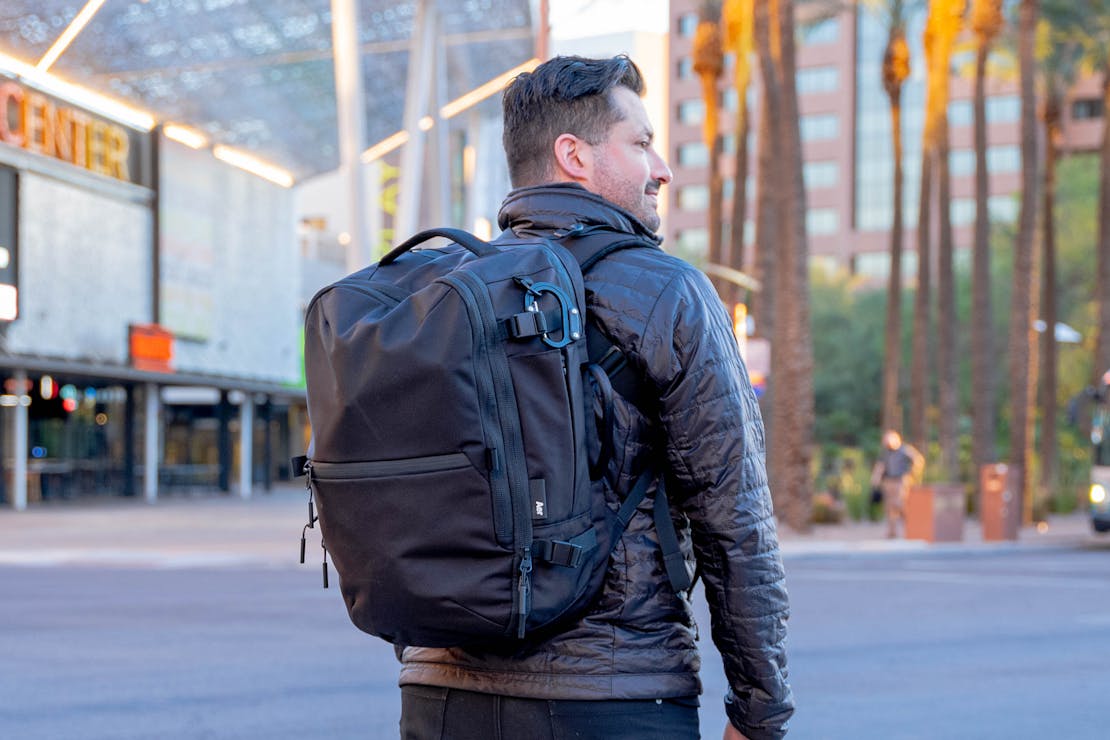
The Aer Travel Pack 3 takes some of our favorite travel backpack features and puts them into one bag: helpful load lifters, easy-to-engage compression straps, and easy access to different compartments. It has Aer’s sleek signature style and is made with quality materials like CORDURA® ballistic nylon and YKK zippers, which add a ton of durability and make this a reliable bag that can withstand extended travel. In fact, this is one of our highest-rated bags and a Pack Hacker Pick because of how it’s held up on trips across the U.S., Thailand, South Korea, and more.

The organization is streamlined for easy packing, and it even includes a hidden pocket where you can tuck a smart tracker—a great feature for keeping track of your bag if it’s stolen or gets lost in transit. The harness system is super comfortable even when the bag is fully loaded and includes wide, cushioned shoulder straps with keepers to cut down on dangling. We also like that there’s an option to add a hip belt because it helps take a ton of weight off your shoulders when the bag is loaded. If you don’t need as much liter space, we recommend the Aer Travel Pack 3 Small because it takes key features from its bigger sibling and puts them in a smaller package built for shorter trips and smaller frames.
Why We Like It
- It has just-right organization and open space
- Compression straps don’t impede access to the compartments, so it’s easy to grab gear quickly
What You Should Know
- Magnetic compression buckles sometimes come undone on their own
- There isn’t a huge false bottom to the laptop compartment, which impacts tech protection—more of a nitpick, as we’ve found it’s still reliable
Best Budget Travel Backpack
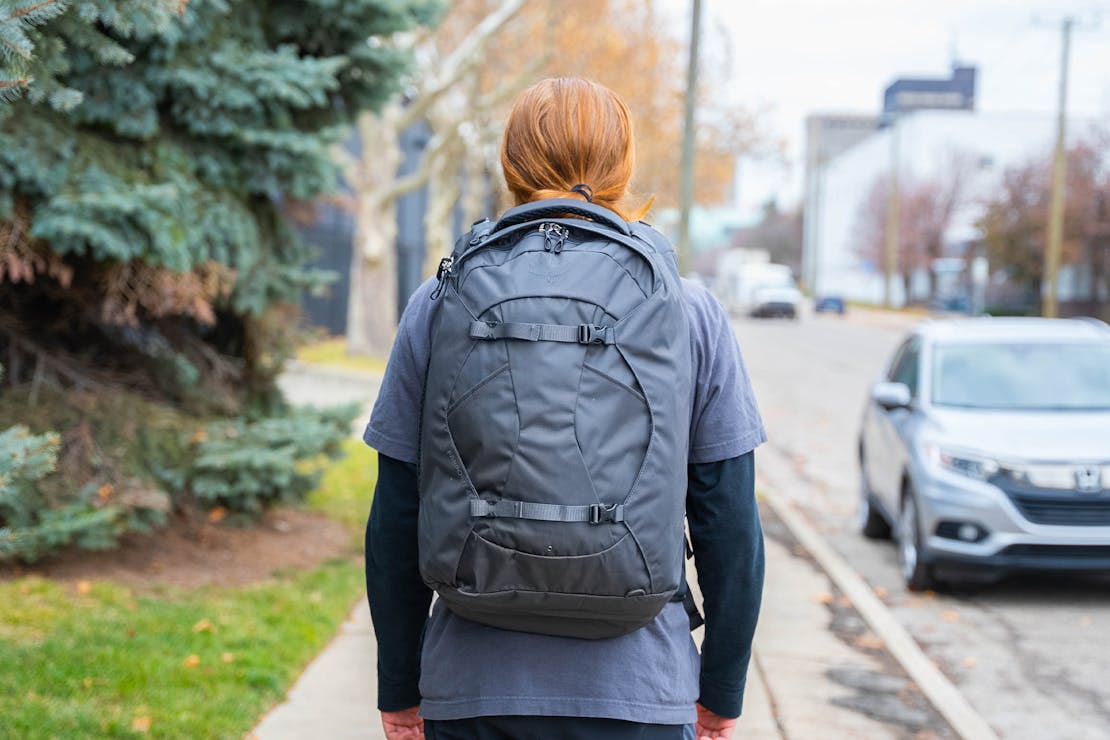
This durable bag is made with recycled and bluesign® approved polyester and a PFAS-free DWR coating, which is great if you’re an eco-friendly traveler. It has a bit of an outdoorsy look, which is to be expected from Osprey. However, the external storage is hard to beat if you’re the adventurous type. A large front stash pocket holds a water bottle or damp gear like a rain jacket or towel, and there’s also a decent-sized top pocket for smaller accessories. We like that it’s big enough to tuck your 3-1-1 bag inside to keep it within reach through the security line at the airport. The main compartment opens fully clamshell, and is easy to pack since you can see all the space at once. A couple of mesh pockets inside help organize your gear, and compression straps hold clothing or packing cubes in place as you travel. The large laptop compartment is accessible from the outside of the bag, so you can get some work done as you wait for the plane to board.
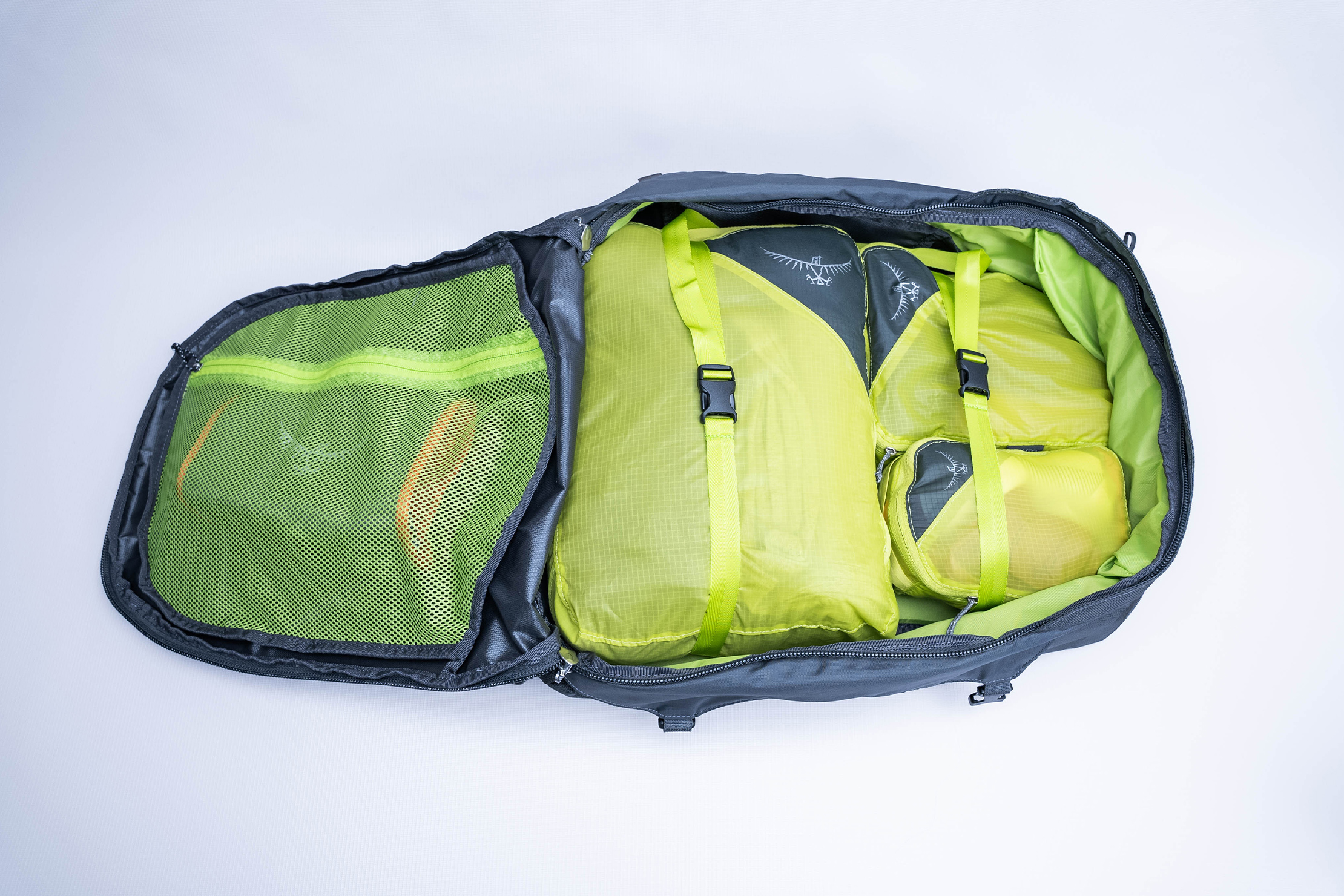
What’s really great, though, is how comfortable you’ll be while carrying this bag. The breathable mesh back panel keeps things airy, and the harness shifts higher or lower so you can adjust it to your height and torso length. If you have a more petite frame but want to carry the same amount of gear, try the Osprey Fairview 40. As opposed to coming straight over your shoulders, these curve in and around, making it easier to carry for more petite users of any gender.
Why We Like It
- The harness system is comfy even when the pack is fully loaded
- An ample-sized main compartment makes this a great pick for one bag travel
What You Should Know
- You can’t remove the bulky hip belt even if you don’t need it
- There aren’t any dedicated bottle pockets, and the front pocket can be tight for larger bottles
Best Splurge Travel Backpack
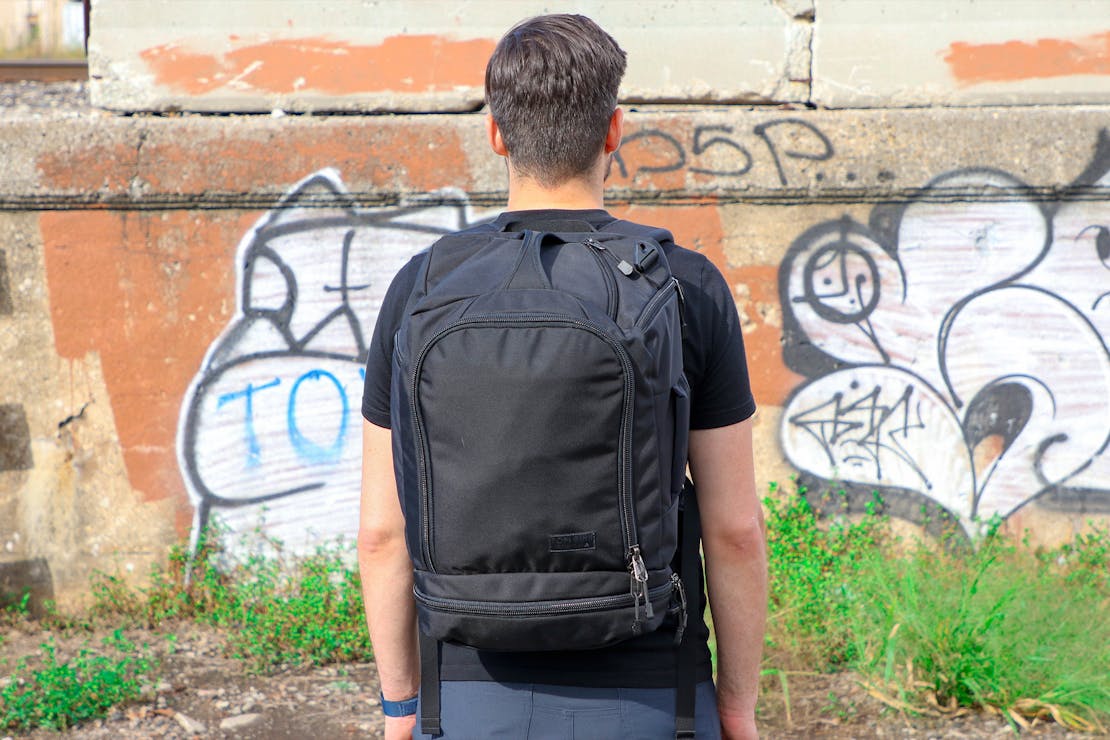
The Techonaut 30 is a classic example of what makes a TOM BIHN bag great. There are a ton of durable fabric and colorway options—we like the 525D ballistic nylon because of its strength-to-weight ratio, though there are stronger and lighter-weight options available depending on your preferences. Plus, it has clever, functional organization that’s easy to load with all your gear. When we need to keep even more small items in check, we add TOM BIHN pouches to the included O-rings around the bag (we’re partial to the Ghost Whale pouches because of their size, but almost any will work).
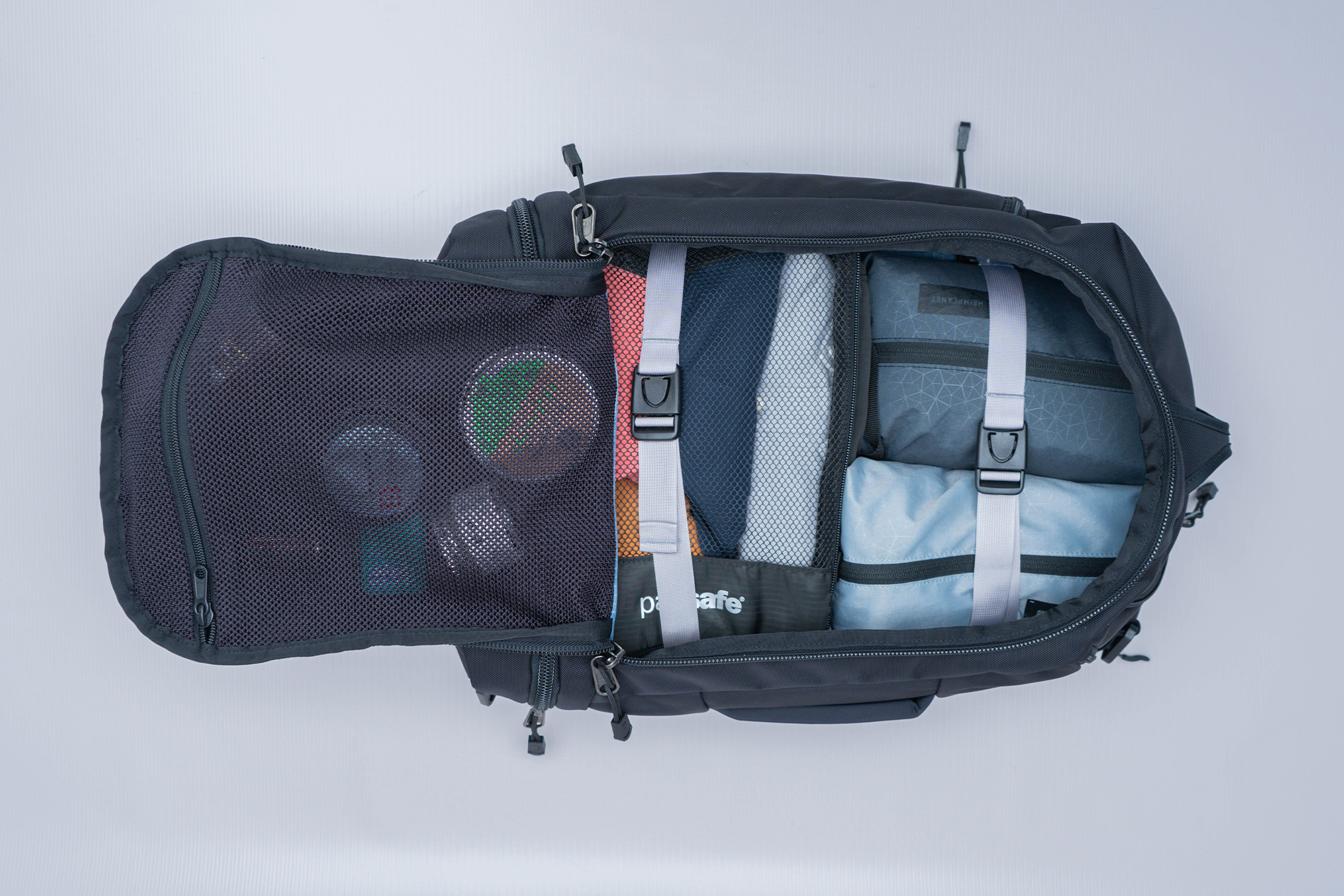
You can carry the Techonaut 30 like a backpack, briefcase, or messenger bag, although you’ll have to get a separate strap to carry it as a messenger. We prefer backpack mode because the back panel is supportive even when all 30 liters are fully packed.
Inside, it has a variety of pockets, including an integrated water bottle pocket and two quick-grab pockets, which work in either horizontal or vertical orientation, meaning you can store gear based on the way you’re carrying the bag. Briefcase mode? Use the top pockets. Backpack? Go for the sides. However, if you need to carry some hydration, we find that the integrated water bottle pocket can cut into the main compartment, so you’ll have to trade some storage space. Though the main and bottom compartments are separated, you can expand the former via a collapsible floor, which is handy if you need a bit of flexibility with the available space. This is great if you like traveling with shoes but don’t want to buy a separate shoe pouch.
Why We Like It
- Bottom pocket unzips to merge with the main compartment for even more storage space
- It can be carried three ways, and all of them are comfortable
What You Should Know
- It’s tricky to see inside the top pocket because of its sideways opening
- The dedicated shoe pocket struggles to fit large shoes, which isn’t ideal for those with large feet
Best Travel Backpack With Built-in Organization
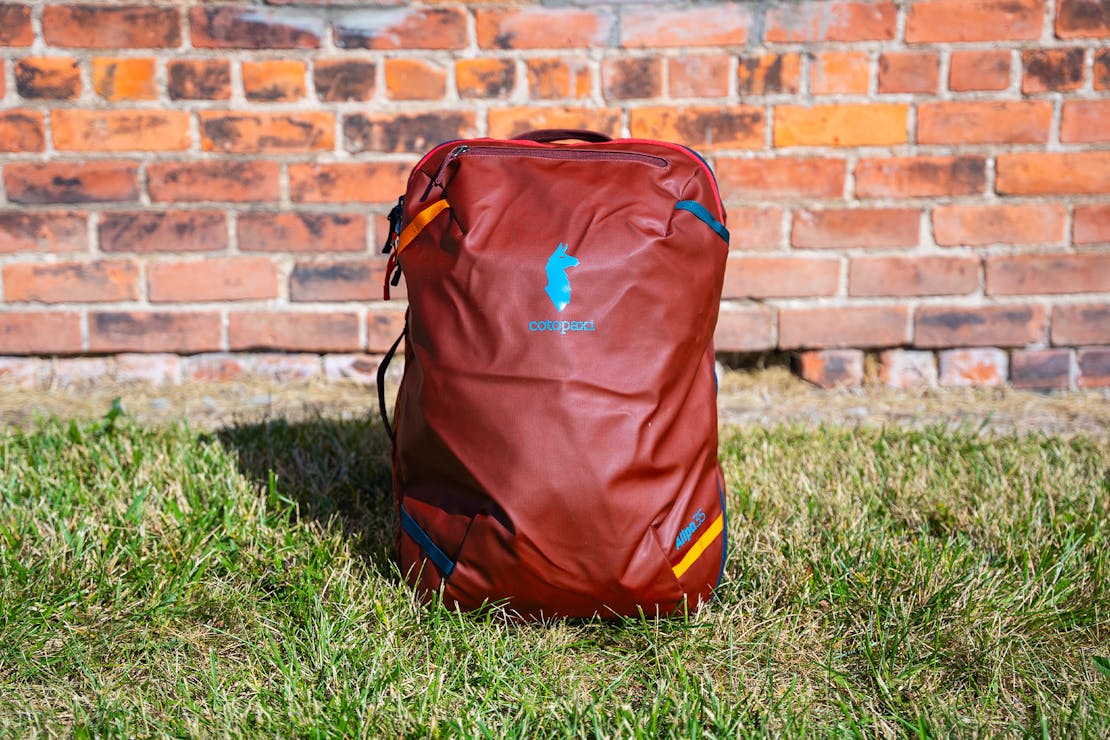
While some travel backpacks fit best in an urban setting, the Allpa 35L Travel Pack works as a hiking or work bag as well as a travel pack. However, just because it can serve other purposes doesn’t mean it’s lacking in the travel department. It has a refined design and ample space that make it easy to pack for vacation, with mesh dividers and organizers inside to help you keep your gear sorted. While the exterior materials aren’t very structured, you’re unlikely to reach for this large of a bag unless you plan to pack it out, so it’s not always noticeable. The polyester is coated with TPU for water resistance, so your gear is safe as you walk in nearly any weather.

If you’re getting started on your journey into one bag travel, you can get the Allpa with an accessory bundle that includes mesh laundry bags, a nylon shoe bag, and a snap-on mesh water bottle sleeve. You also have the option to add-on Cotopaxi’s Batac Daypack, so you can have a complete travel system ready with just one click. And in case you needed another reason to consider Cotopaxi, you should know that their bags are made in the Philippines in a factory committed to fair labor and environmentally-sound practices, so you can feel good about your purchase, too.
Why We Like It
- It’s a ruggedly durable backpack if you’re a more adventurous traveler
- The bag feels roomy and conveniently-placed pockets for small gear storage
What You Should Know
- Hip belt isn’t removable if it doesn’t fit, and the pockets often feel too snug when wearing the bag
- It’s on the heavy side for its size
Most Comfortable Travel Backpack
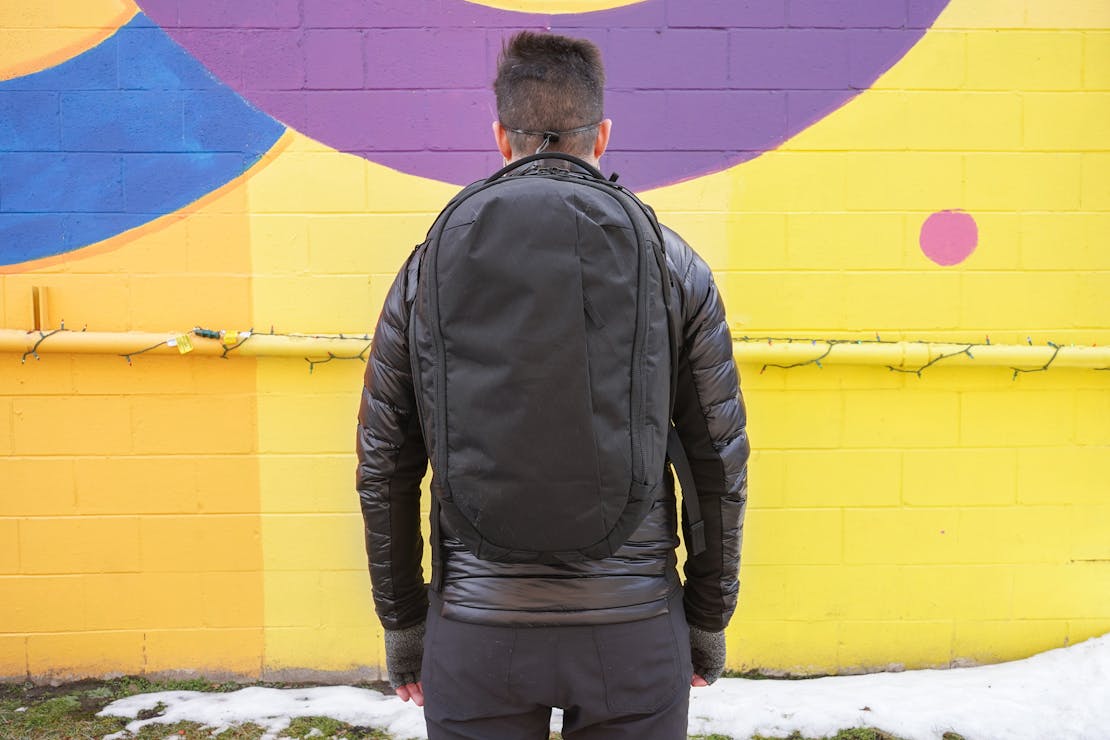
The VX21 X-Pac material on the Able Carry Max Backpack gives it a sporty look that we like, and there’s also 1000D CORDURA® nylon on the underside for durability. You won’t have to worry about the sturdiness of this bag, as it’s well-constructed, with reinforced stitching in key areas. There is plenty of room in the laptop compartment for up to a 17-inch computer and organization for your tech gear. Loops and strips of webbing around the bag give you the flexibility to pack it however you wish, and there are two quick-grab pockets for gear you want to get at as you travel. You can even get a third quick-access spot if you use the internal bottle pocket instead of the one outside the bag for hydration.
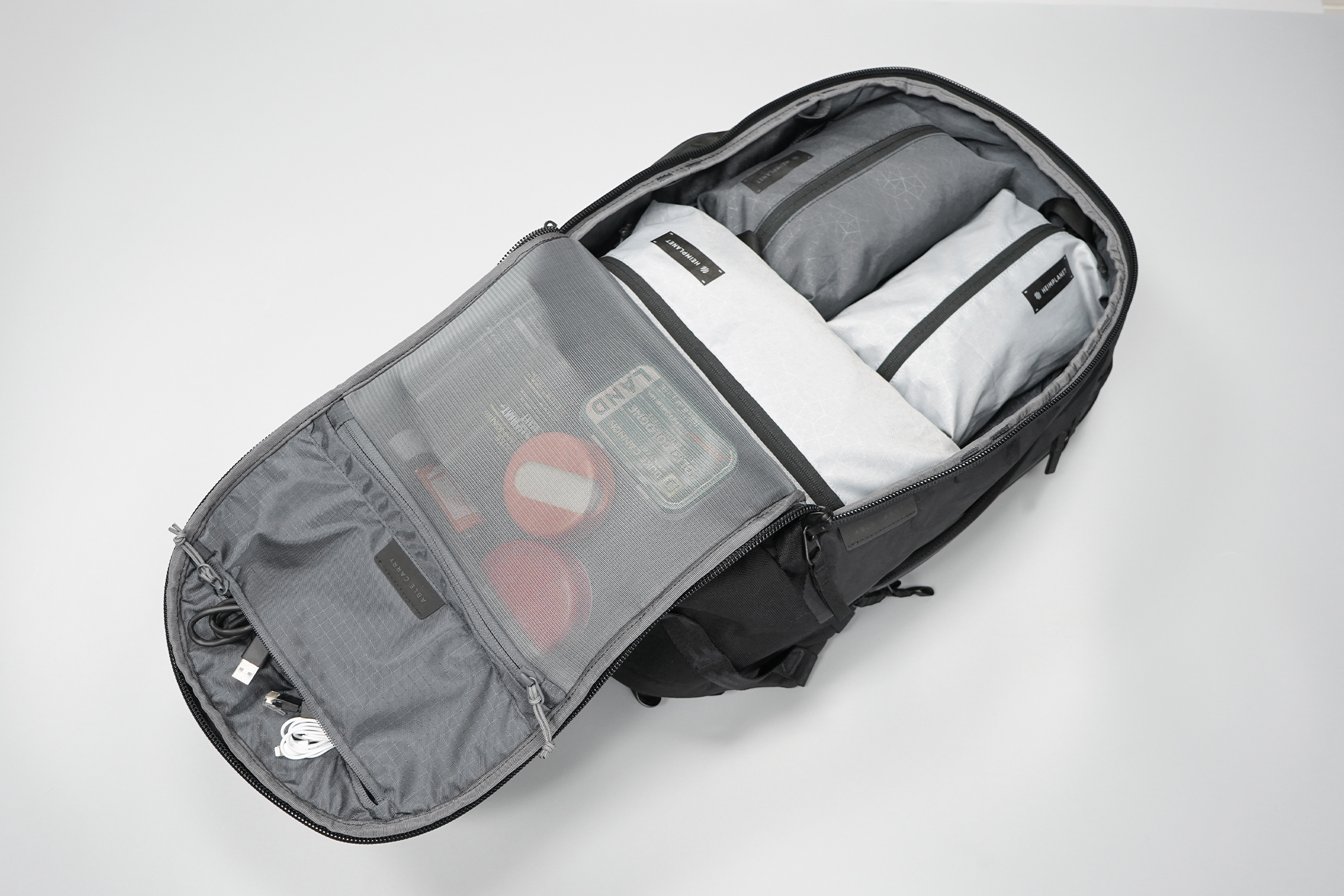
The Max Backpack is really comfortable to carry and easy to adjust. The shoulder straps have dense padding and breathable mesh undersides, with X-Pac on top for durability and style. While the tablet pocket is a bit shallow, we don’t have too many problems during regular use.
Why We Like It
- It’s easy to customize organization thanks to webbing and loop attachment points
- The durable fabrics are held together with equally-sturdy stitching
What You Should Know
- The X-Pac material may not suit everyone, though you can always opt for CORDURA® nylon
- A rear pocket is a bit narrow and tricky to access
Other Travel Backpacks We Love
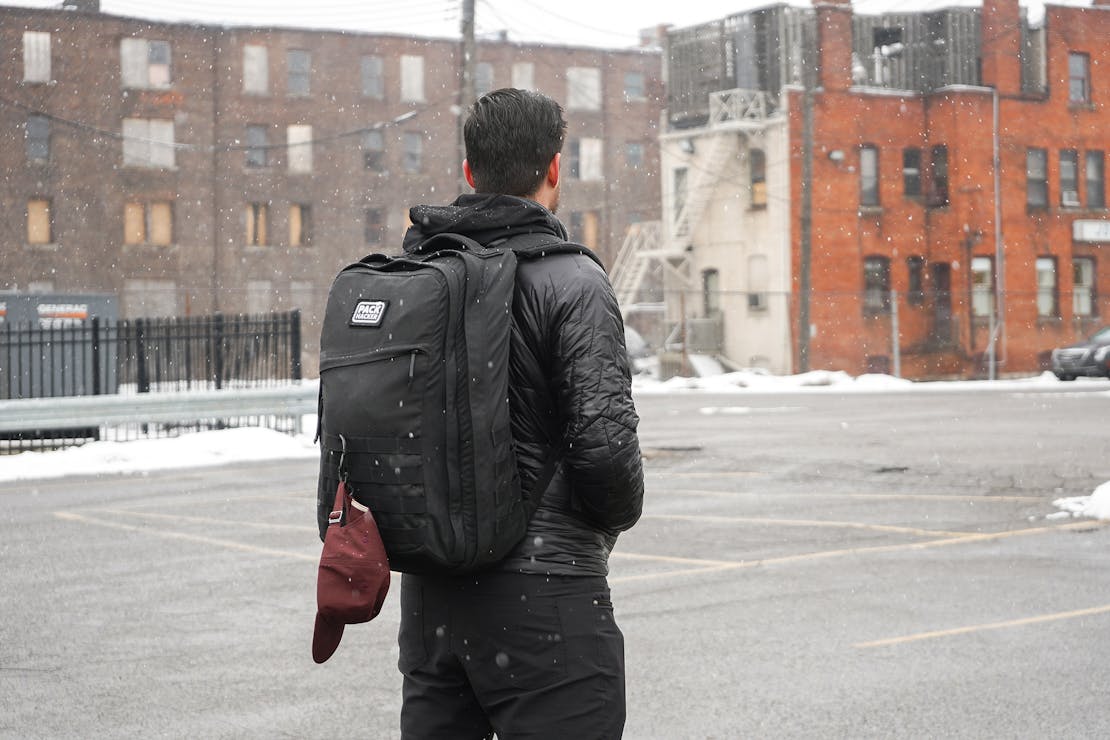
If you’re looking for a durable pack that can handle any adventure you throw at it, look no further than the GORUCK GR2. It’s a little on the heavier side (courtesy of the CORDURA® Nylon and beefy YKK zippers), though we think the durability is worth the weight sacrifice. Plus, it now comes in a few lighter materials if that’s a dealbreaker. We’ve fit its boxy shape under the seat in front of us on some budget airlines, which is great if you’re trying to avoid fees while you travel the world (who isn’t?). In fact, this is the bag that Pack Hacker’s founder Tom used to travel the world for over 2 years.
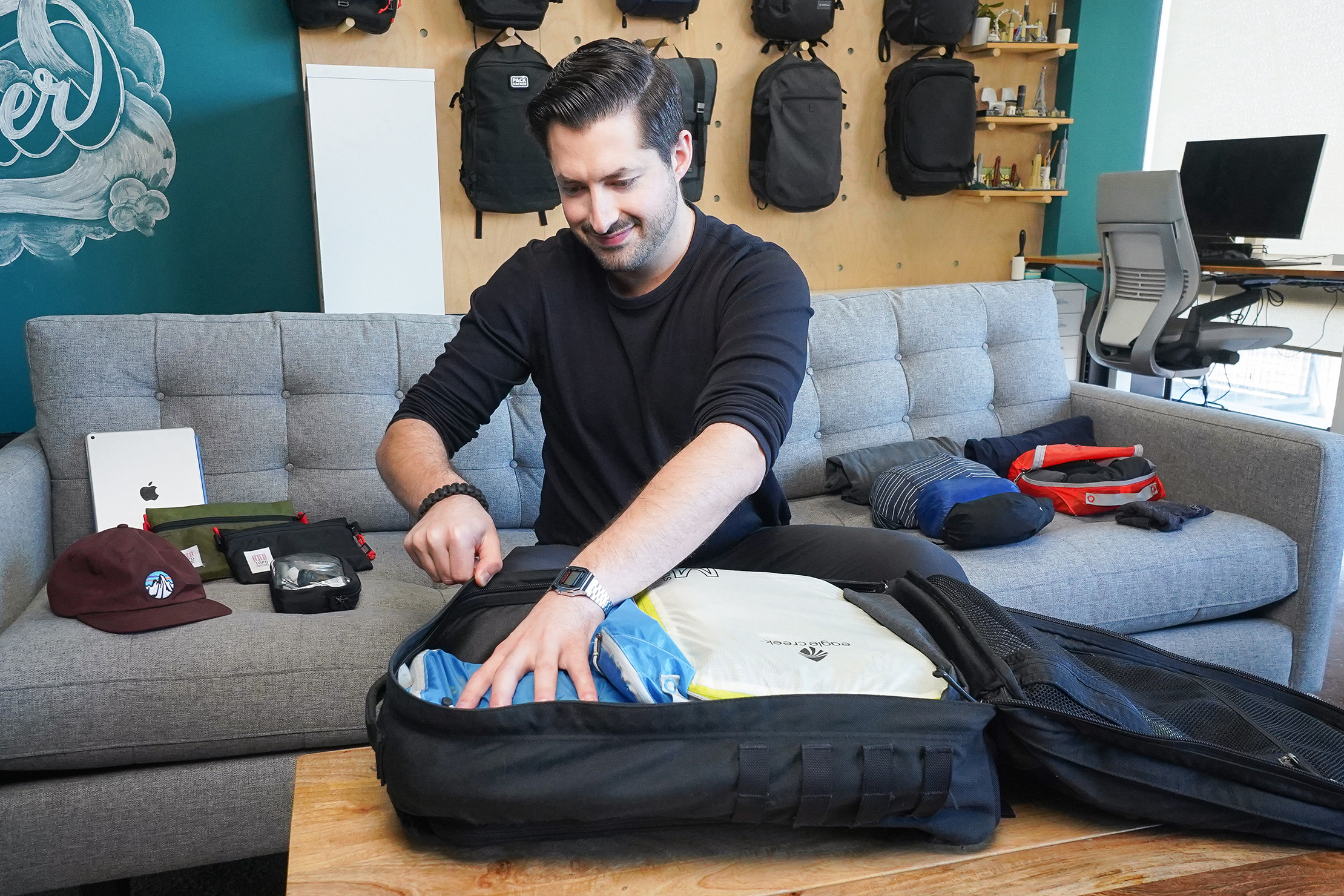
Though the organization inside is simple, there’s still plenty of room for packing cubes and pouches. It’s covered in PALS webbing, which we use to attach MOLLE accessories like pouches that we fill with items we want quick access to on the plane or while exploring. The customization options mean you can make the pack fit your specific needs, whether it’s Digital Nomad travel or a weekend fishing trip with your family. Plus, GORUCK has one of the best lifetime warranties in the business and a killer repair program, so if you have any issues, contact their customer service.
Why We Like It
- The external fabrics are some of the most durable we’ve seen—it even held up when we dragged it behind a car
- Plenty of PALS webbing, so it’s easy to add modular MOLLE attachments to customize your organization
What You Should Know
- The rugged materials and hardware add a lot of weight to the pack
- It has a tactical look and feel that’s hard to disguise if that’s not your style
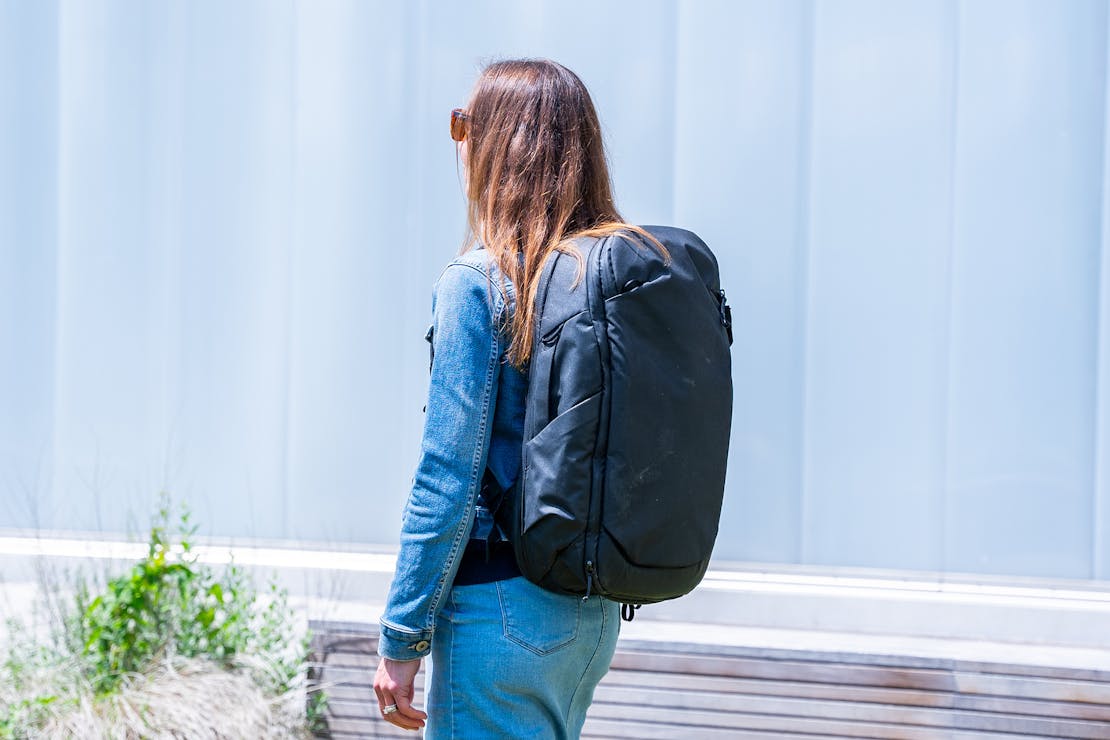
Since this is a bag from Peak Design, it has some great camera features. There are plenty of attachment points inside and out for your photography gear. However, it’s an excellent travel backpack even if you don’t take a DSLR on every trip, thanks to its clean lines and clever design.
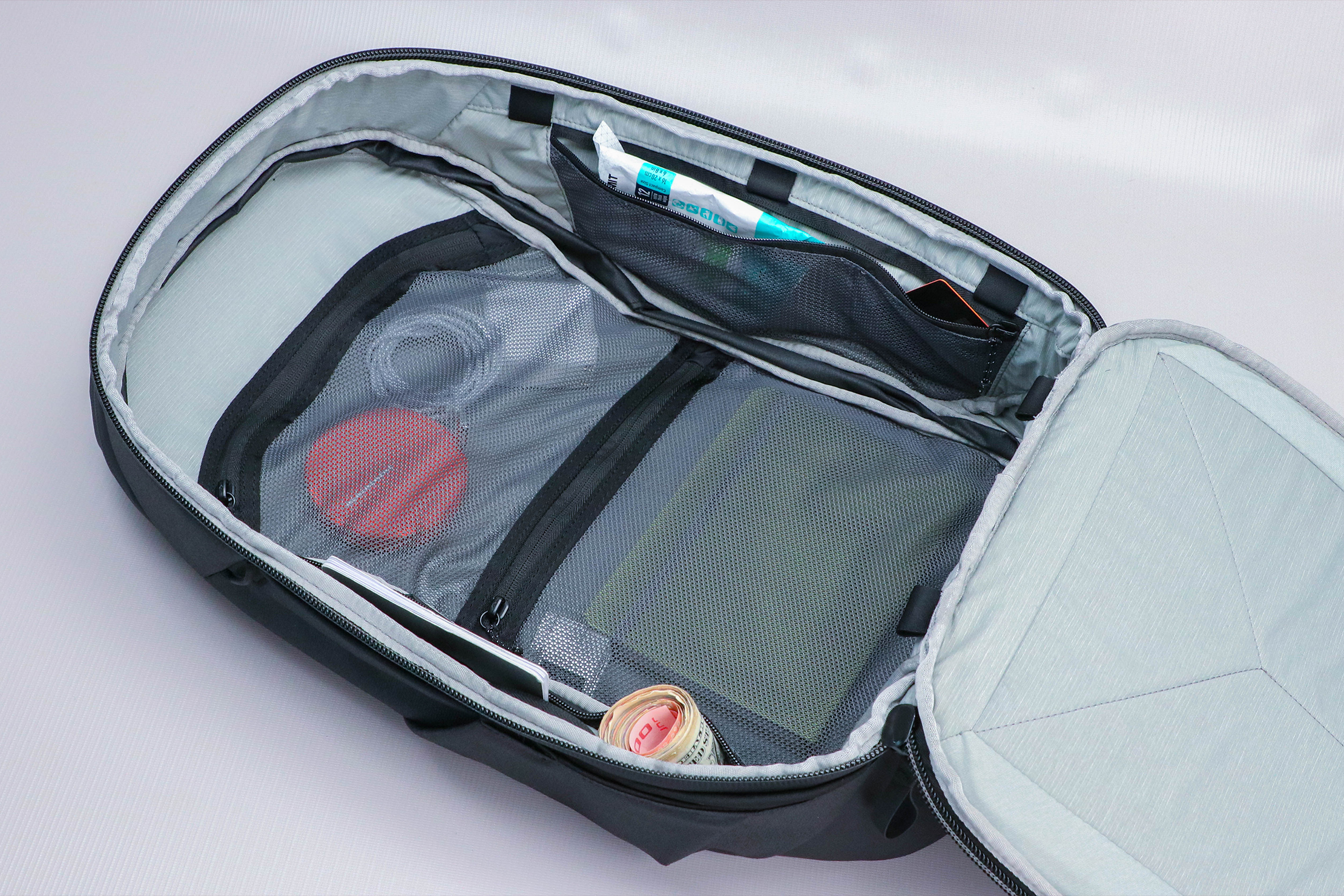
The main compartment has well-structured sides and opens clamshell to make it easy to pack, although we’ve noticed that anything we store on the bottom blocks built-in mesh pockets, so you’ll have to choose between gear storage or smooth access. They’re useful for gear you won’t need until you reach your destination, and side pockets help you get to things that you need as you travel, like your passport. There’s a well-padded sleeve for your laptop, and the front pocket has organizational features for tiny gear, which is great for getting to your essentials while sitting in your airplane seat or waiting at the gate. For times when you’re not packing as much, the compression system does an excellent job at holding gear in place.
If you find that 30L isn’t enough space or you want bring more of your photo kit, we recommend the Peak Design Travel Backpack, which has the same great features and added room for your gear. It expands to 45 liters if needed and has compression snaps to lock it down if you want to use it as a daypack.
Why We Like It
- It has a comfortable harness system, with a sternum strap that won’t slip out of place
- Structured sides and clamshell opening create a bucket shape that’s easy to load with gear
What You Should Know
- ID pocket on the back panel is easy to overlook, so a stranger may not see it if they find your misplaced bag
- Some main compartment pockets aren’t as accessible as we’d like, which slows you down when searching for gear
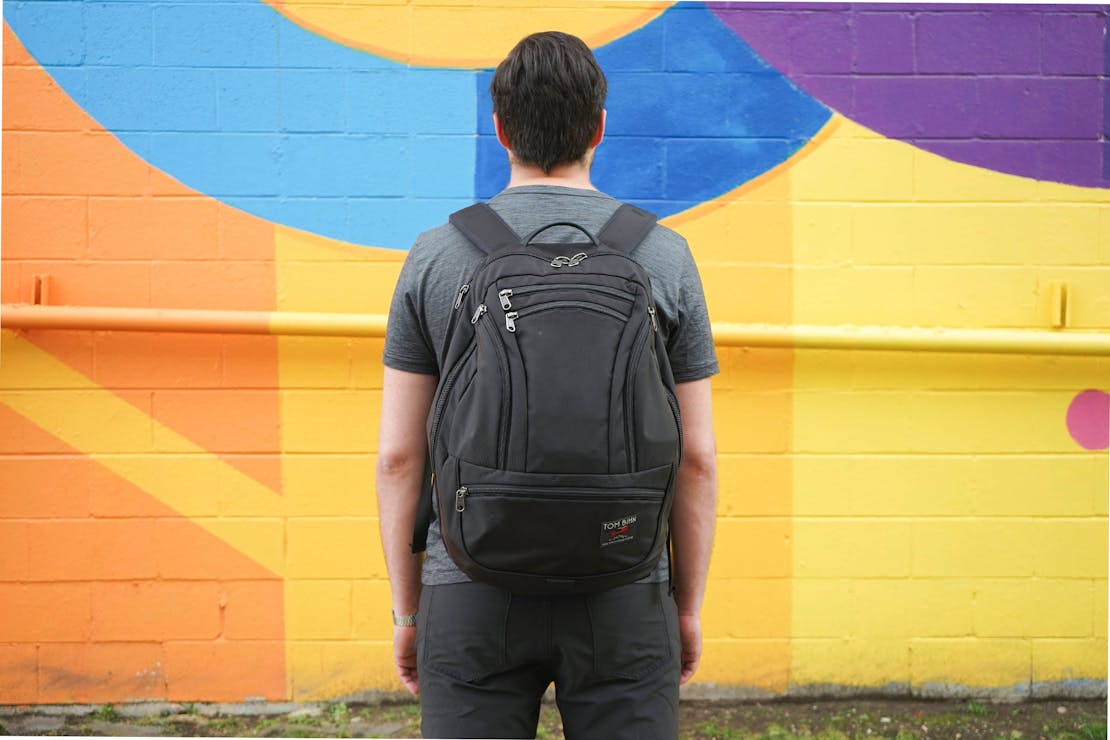
Going with a lower-capacity pack reduces size and weight, meaning you can even use it as a daypack once you arrive at your destination. However, that doesn’t mean it has to be short on features. Enter the TOM BIHN Synik 30. It’s a smaller version of the Synapse and features the same top-notch and customizable organization we’re used to seeing from TOM BIHN. That means it has multiple exterior pockets for storing gear and numerous attachment points on the interior for attaching modular pouches. While we like the ballistic nylon options because they’re sleek and durable, you can opt for a different material if you want (TOM BIHN has a ton to choose from).

The style won’t be for everyone, and its round shape can make it more challenging to pack some packing cubes and pouches, causing you to lose out on some storage space in the corners (or lack thereof). However, once you’re used to the internal organization, this is one of the smartest-designed internal layouts we’ve seen in a travel backpack.
Why We Like It
- The internal organization is great for both travel and daily carry
- Plenty of options to add modular pouches to customize gear organization
What You Should Know
- Has a heritage look that may not be everyone’s taste
- Rounded edges can make it harder to pack with some organizers and pouches
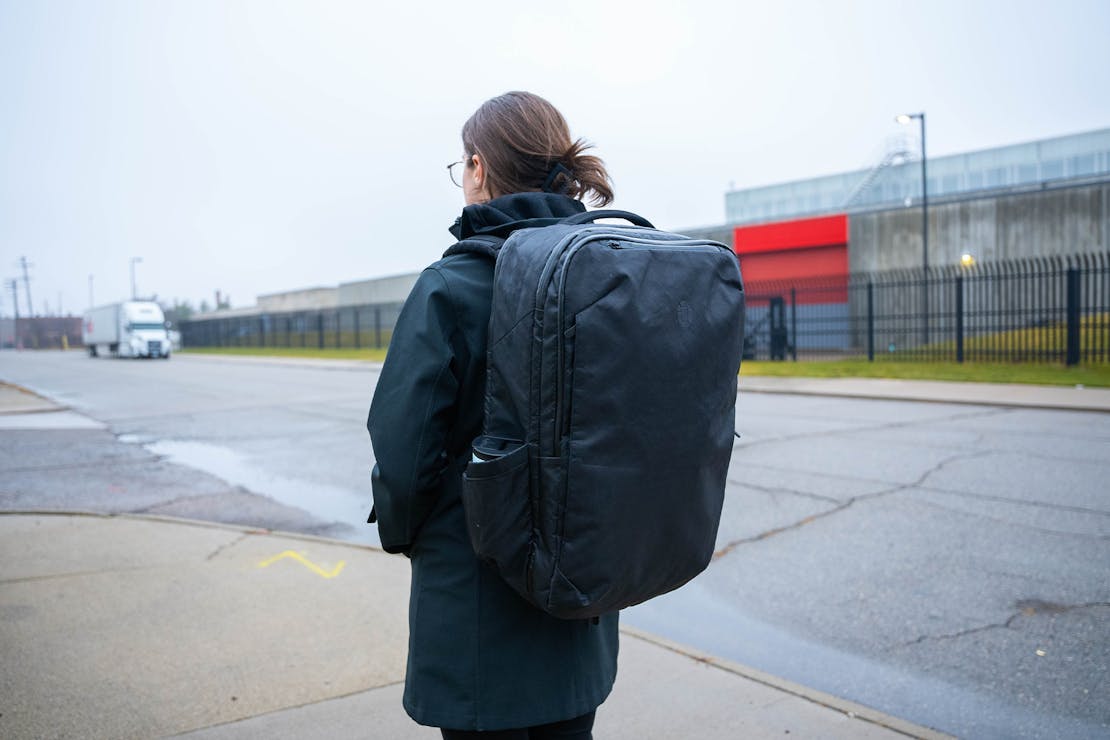
The Tortuga Travel Backpack 40L has a thickly padded harness system, from the shoulder straps to the hip belt and the back panel, along with vertical height adjustment and load lifters for extra support. All of these features together make for a comfortable carry even when the backpack is completely full. There are plenty of places to pack your gear, including water bottle pockets on each side, a top pocket for small items like keys, a front pocket for wide but flat items, and smaller pockets on the hip belt. You can stash your tech accessories in a well-organized admin panel, and there’s a dedicated laptop compartment as well. It includes a zippered pocket for accessories, which we love for the trips where we don’t need to bring a separate tech pouch.
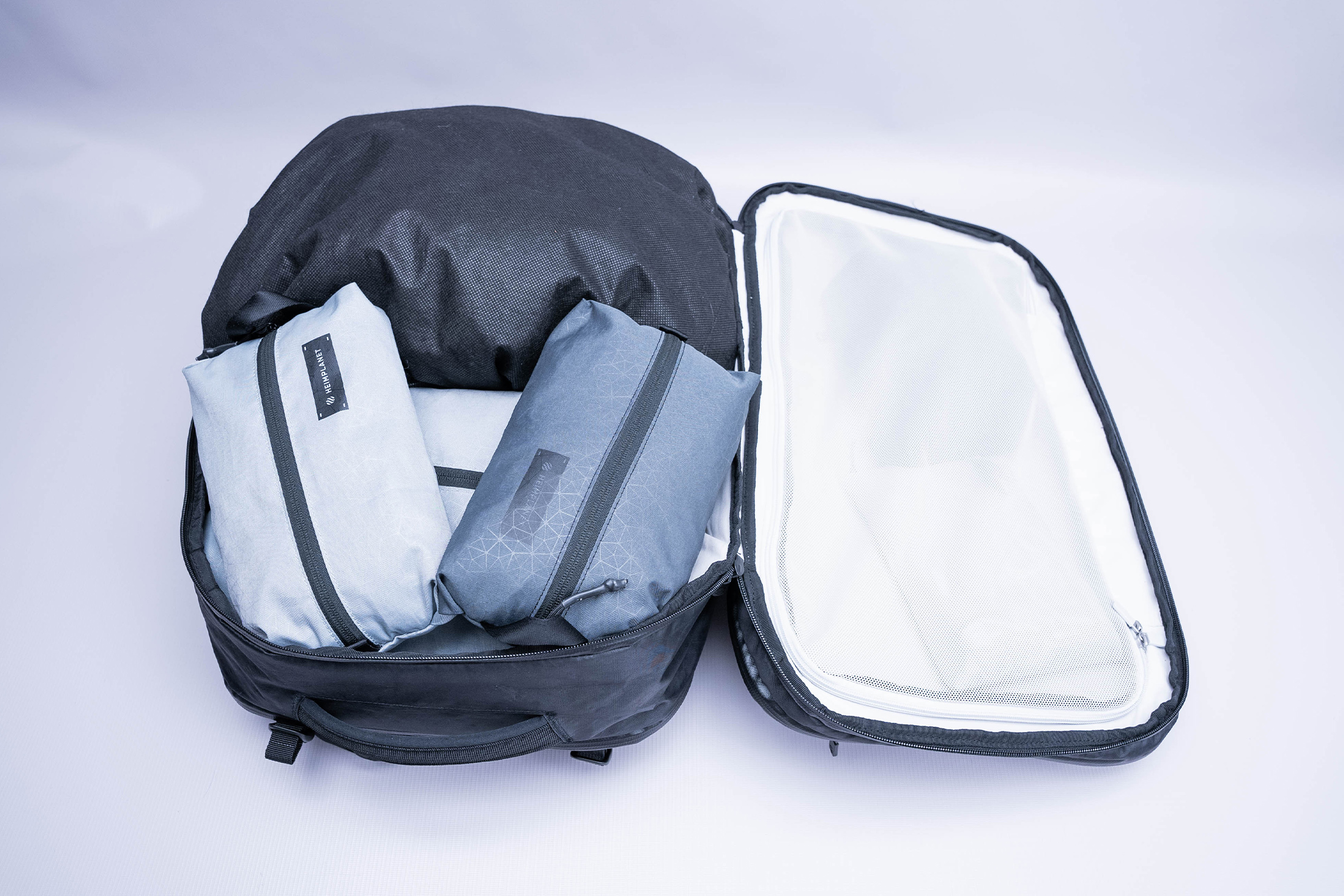
The large bucket space of the main compartment is simple, with no dividers to get in the way. This means you can pack however you please, whether you load up on packing cubes or fold your clothing into neat piles—though we recommend packing cubes so that things don’t get too jostled. If you’re vehemently against cubes (an interesting hill to die on, but we get it), a mesh compartment hinges along the main compartment opening for some built-in segmentation and is deep enough to hold a single layer of thick clothing or a couple layers of thinner items.
Why We Like It
- Structured material holds its shape regardless of how much gear is inside
- Simple organization in other pockets while the main compartment is open to organize as you see fit
What You Should Know
- Can be slow to access the large mesh pocket in the main compartment because it opens toward the inside of the pack, not the outside
- The harness system can feel a bit overkill for a bag of this size if it’s not full
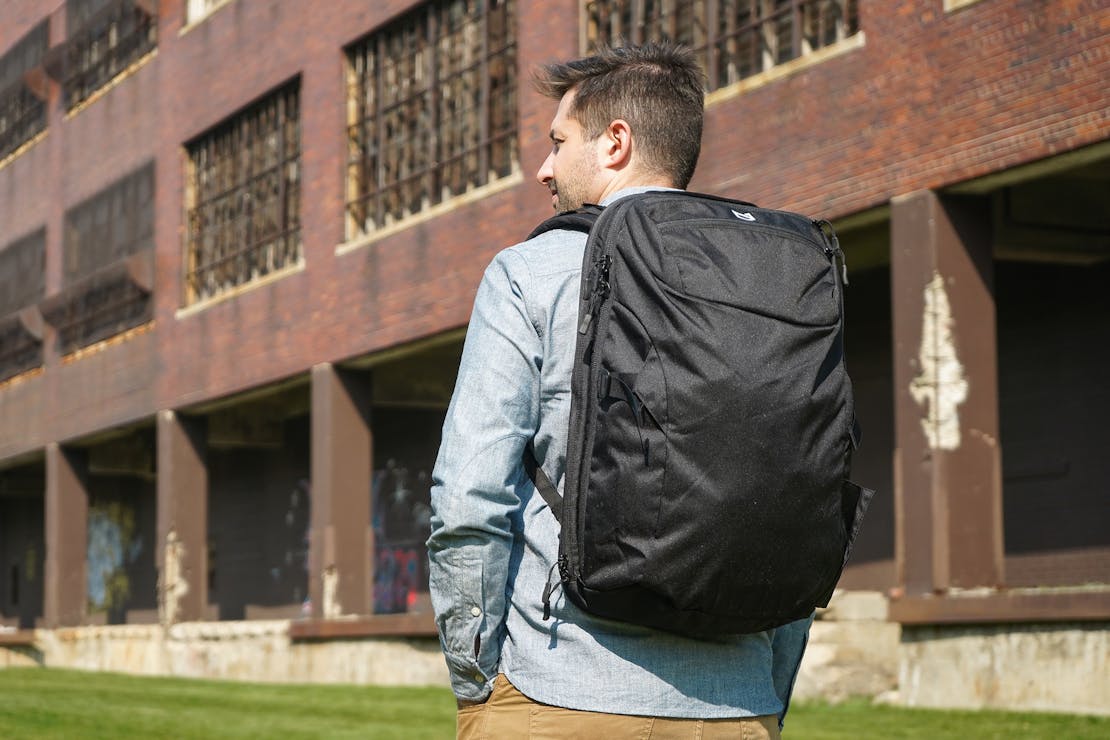
The 35L Minaal Carry-On 3.0 for one bag travel is aesthetically sleek and has smart features to improve quality of life on your trip. If you carry a lot of tech, you may appreciate that the laptop compartment lays completely flat, making it easy to load and access on the go. It has a suspended laptop sleeve that you can adjust to different sizes, so your 13-inch MacBook Air isn’t drowning in a pocket designed for a big gaming computer. Plus, the shoulder straps hide away behind a zipping panel, which we find makes it easy to slide this backpack into an overhead bin.
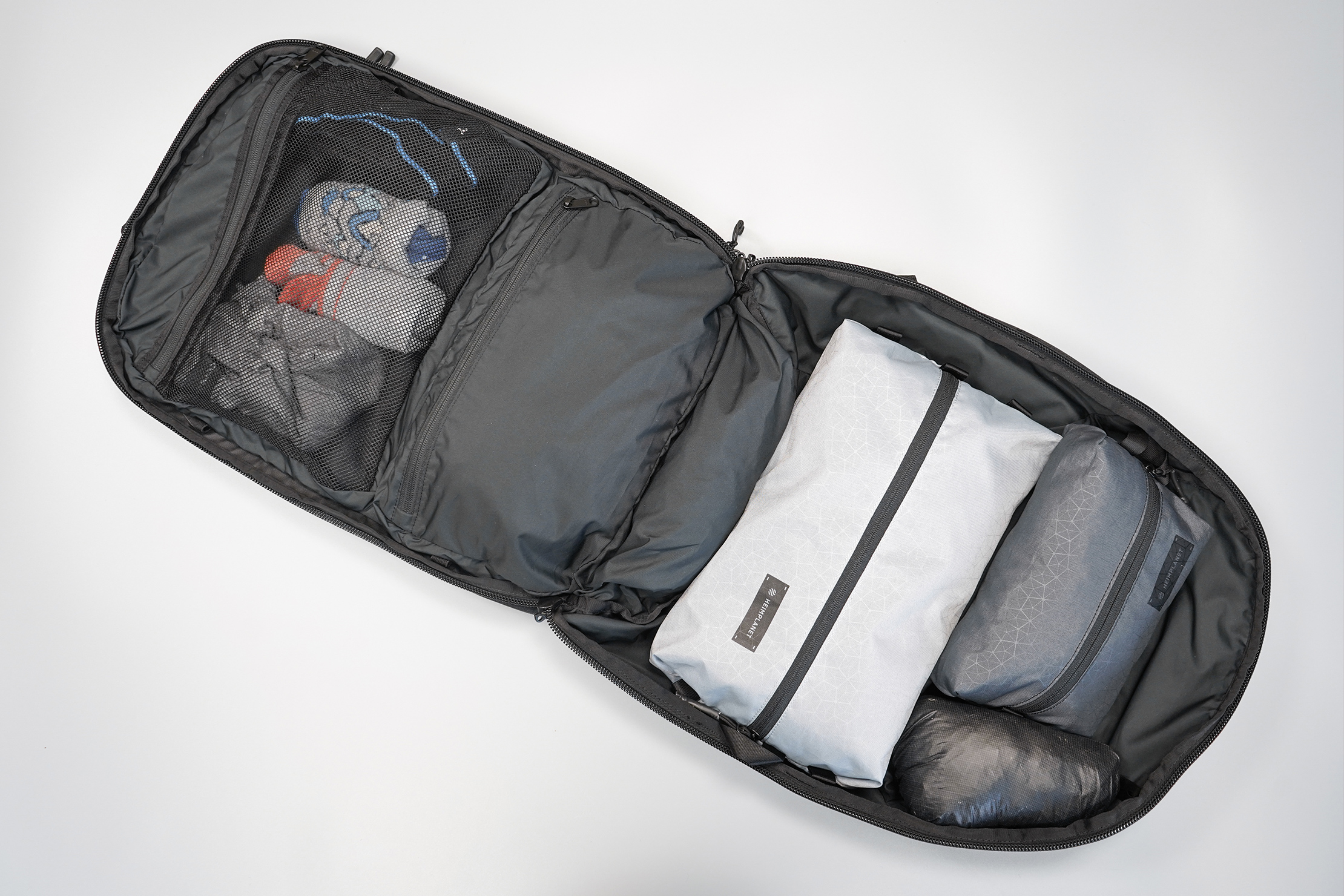
The main compartment opens clamshell for easy packing and includes some built-in organization. However, unlike most other backpacks, you load the bag into the “scoop” section (the front of the bag) instead of the back. This takes a little getting used to, though it’s easy to use once you do. While we recommend taking advantage of packing cubes for most of your gear, there is a large mesh pocket at the top, along with a nylon pouch below it where you can pack shoes. Two external pockets give you quick access to your wallet, phone, and small accessories, and there’s also a security pocket behind the back panel for your passport. Just be careful when using the water bottle pocket, as they can slip out even when the bungee is tight.
Why We Like It
- It’s great to be able to securely carry devices of different sizes in the adjustable sleeve
- Excellent accessibility since both compartments open fully clamshell
What You Should Know
- You have to pack it “scoop side down,” which can get unwieldy without packing cubes
- The bungee designed to hold a bottle in place doesn’t always work as intended, and some bottles slip out
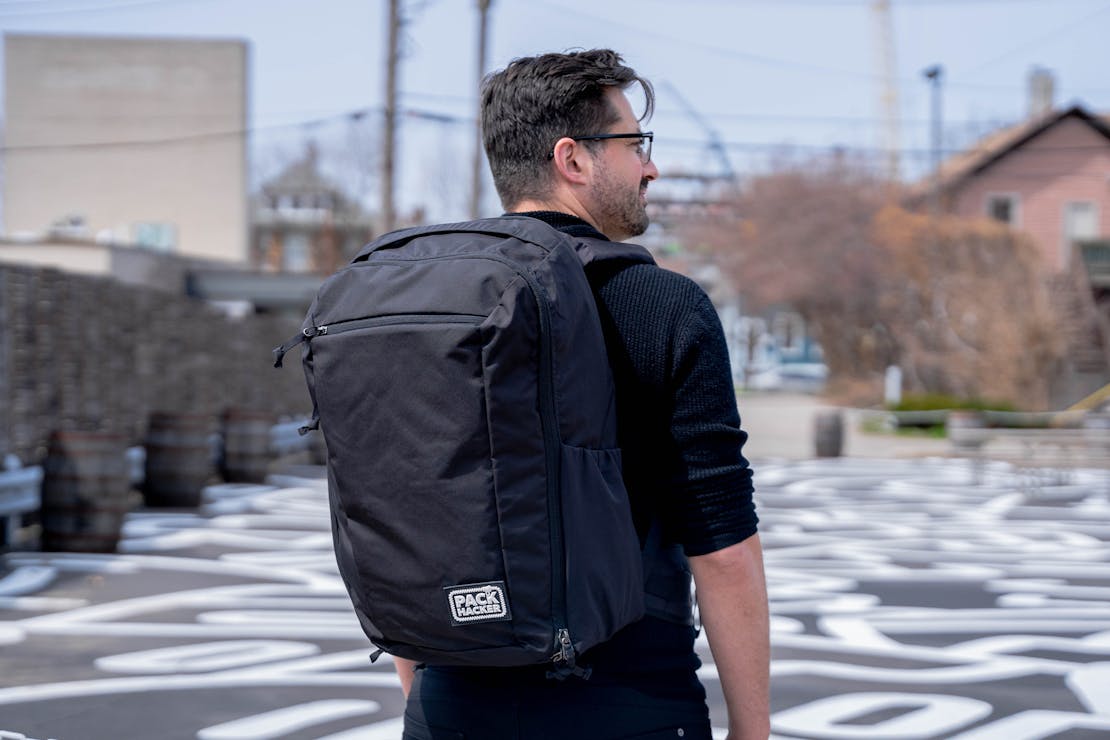
Some packs are designed with a specific use in mind, and others are designed to be as versatile as possible. Every once in a while, you’ll come across a bag that does both (and does it well). The features on EVERGOODS’ Civic Travel Bag 35L, or CTB35, make it one of the most versatile travel backpacks we’ve seen on the market.
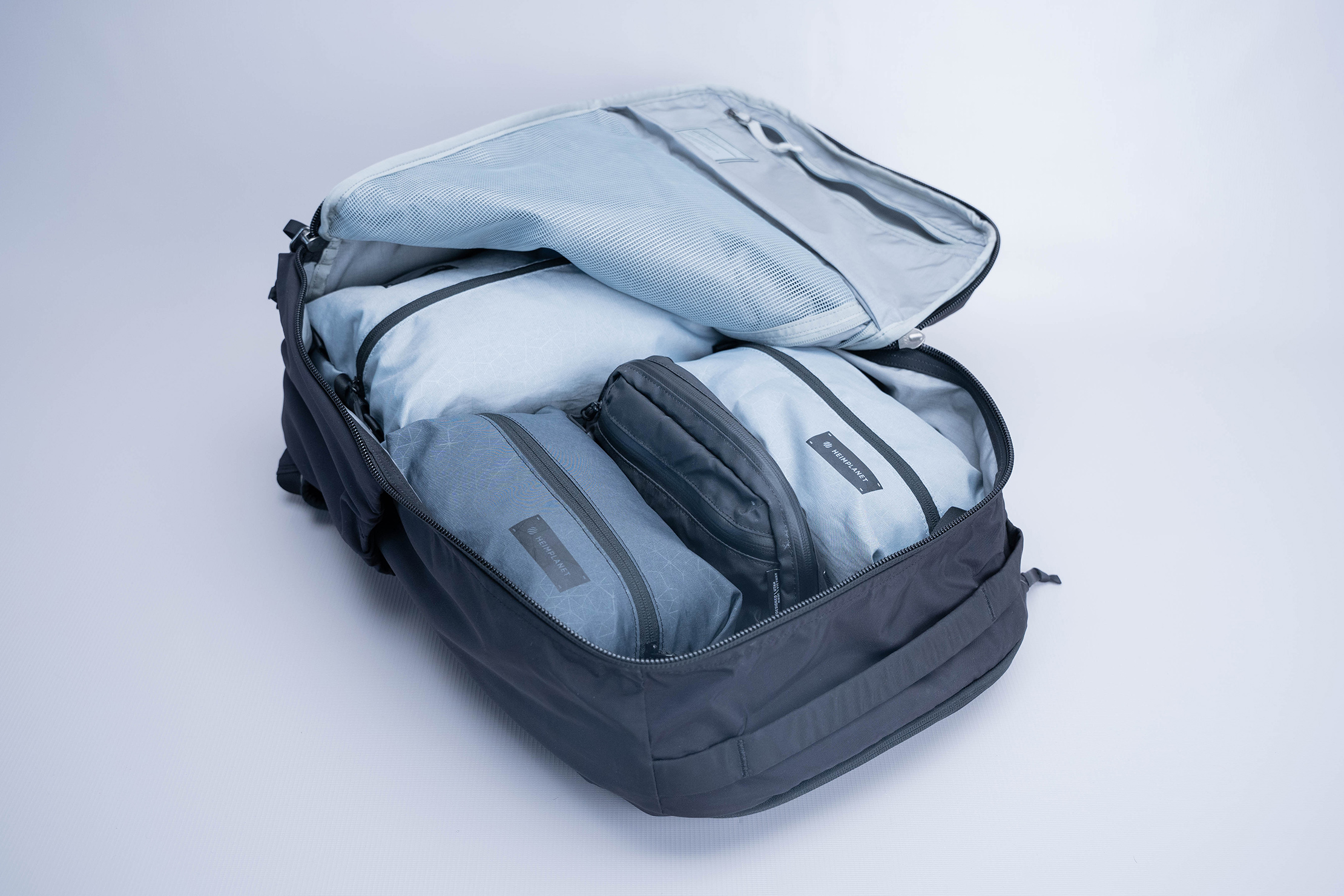
There’s plenty of organization to choose from without going over the top, meaning there’s a spot for large and small gear alike. The main compartment has ample space, so we’re able to fit everything from a camera cube to bulky shoes inside, and it even has a few zippered pockets for small items like tech. As for external storage, there’s a built-in yoke pocket on the top and a vertical zippered pocket on the front that we like to use as a dump pocket for our phone, wallet, keys, and more while going through airport security. Plus, there’s an easily accessible laptop compartment if you work on the go. The harness system is contoured nicely, which makes this backpack incredibly comfortable to wear even when fully packed, so we have no problem carrying it all day long.
We like the 35-liter option because it’s big enough to work for long trips. However, if you’re into the organization but want something smaller, it also comes in a 26-liter size (which we like equally as much).
Why We Like It
- The harness is well-padded and comfortable even when the pack is completely full of gear
- It strikes a balance between built-in organization and empty space, so you’re not pigeonholed into packing your gear a specific way
What You Should Know
- Since the organization is so minimal, you’ll need to find a way to manage things like clothing—we recommend utilizing packing cubes
- We find it difficult to stow the hip belt without it twisting a bit, so it takes a bit of finesse to get right
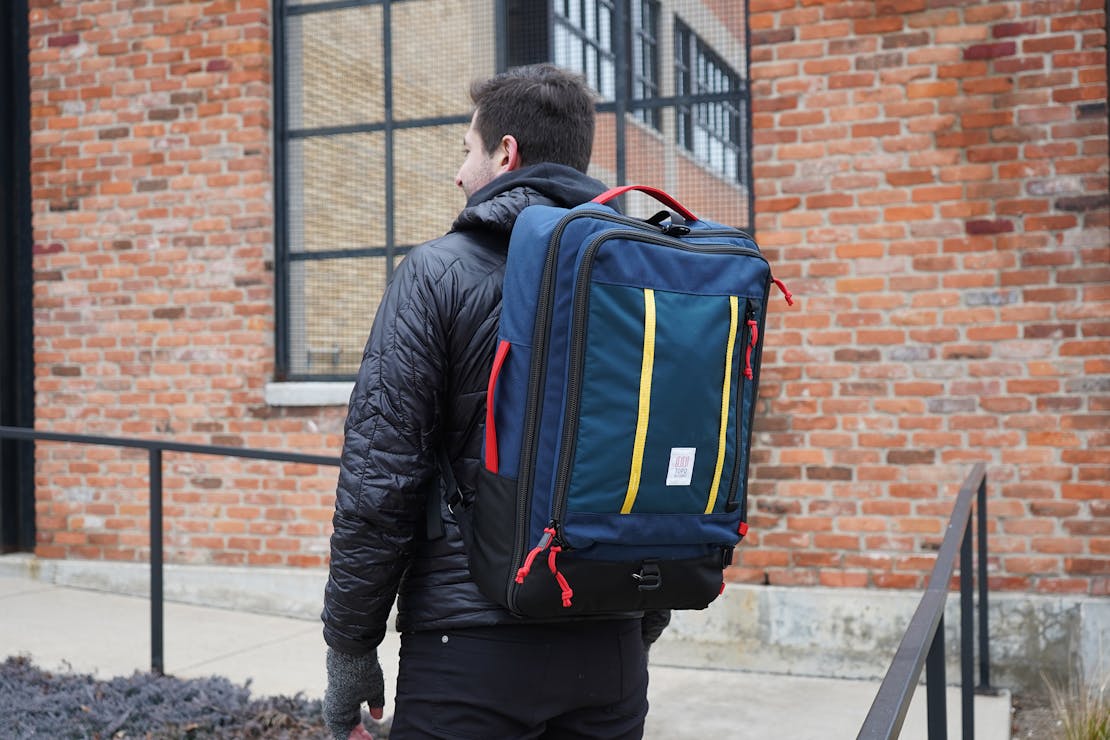
We like the Topo Designs Global Travel Bag so much that we chose it for the first iteration of our Vacation Packing List. The large size makes sense because you can fit more gear; however, there’s a smaller 30-liter size that we find is better for smaller-framed folks and people who want to save space. Why do we like it so much? We’re happy you asked!
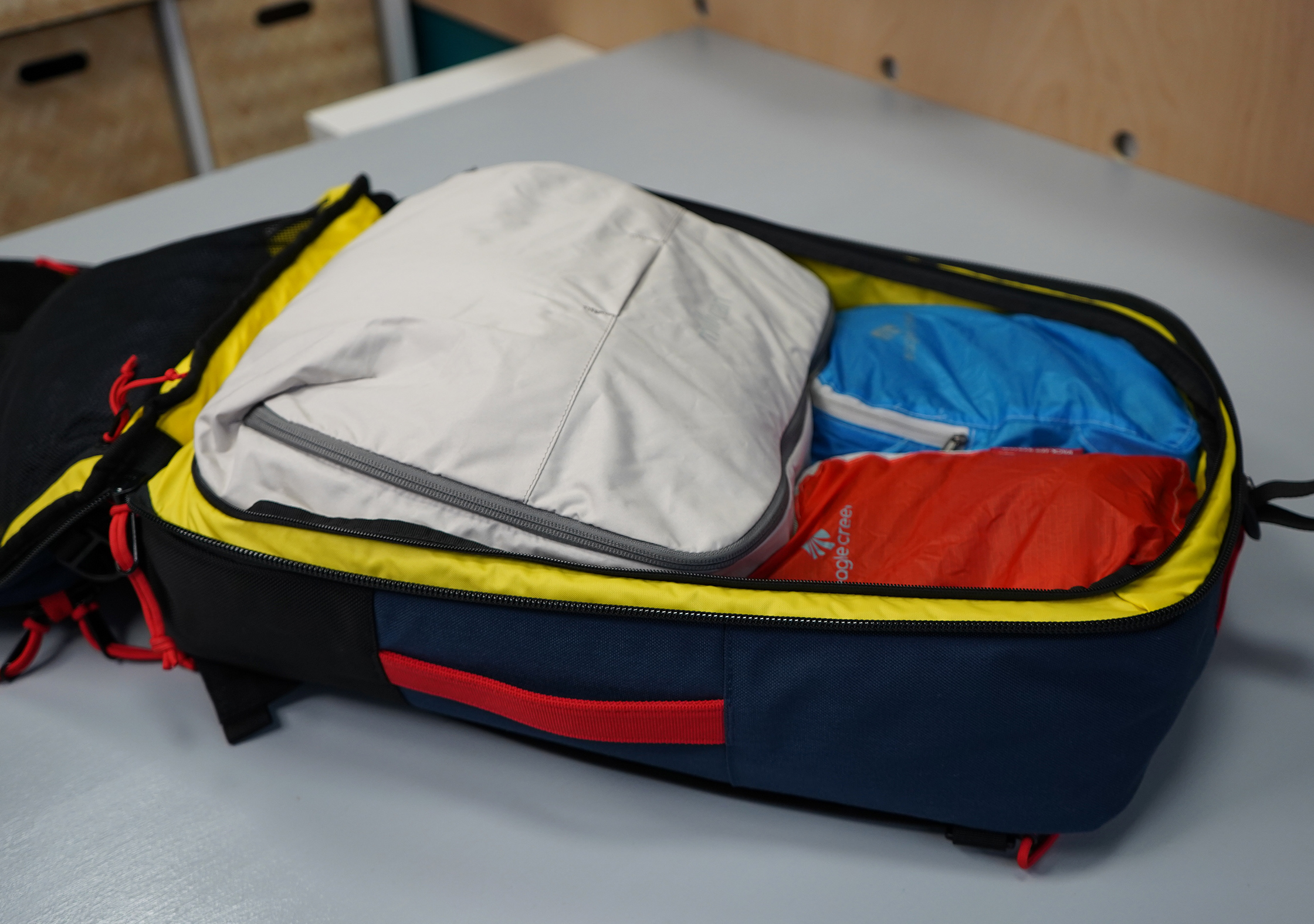
These packs have built-in organization options inside the main compartment, including a divider with zippered pockets that we use to stow smaller items like socks and underwear, but it’s also great for tech or miscellaneous gear. There’s also a large second compartment, a dedicated laptop compartment, and a quick-grab pocket on the front that’s handy for gear you’ll need throughout the day. While all of this organization is great, it’s worth mentioning that all of these zippered pockets are pretty shallow, so you’ll have to pack strategically to ensure your bag will zip up when everything is loaded in. On the plus side, the liner is brightly colored, which makes finding your stuff that much easier!
If all of that space isn’t enough for you, there are attachment points on the front of the bag where you can attach an additional daypack. The harness system isn’t our favorite because there’s no frame sheet to add structure and it can feel pretty heavy when it’s all packed out, but the hip belt does a good job taking some weight off your shoulders.
Why We Like It
- There’s ample organization to segment your gear, making it easier to find
- The bright liner material adds a ton of visibility when we’re looking for our stuff in the multiple zippered pockets
What You Should Know
- Can be difficult to slide a laptop into the dedicated compartment when the bag is fully packed because of how it starts to bulge
- It’s not the most comfortable bag we’ve worn for extended periods because the back panel lacks significant structure
Editor’s Note
June 13, 2025: Our introduction now features our top five travel backpacks that satisfy specific needs.
February 21, 2025: We clarified what differentiates a travel backpack for women from standard travel backpacks on the market.
November 1, 2024: We narrowed down our list of the best travel backpacks at the top of this guide to include a range of top picks that satisfy different needs. We also added more details to the guide, such as how to find your torso length and which bag features enhance your carry comfort.
Others We Considered
Though it’s a great size for those who want a carry on backpack that’s small enough to be a personal item, we ultimately decided against the CabinZero Military Backpack 28L because it gets uncomfortable to carry when it’s packed to the brim. Since it’s so small, that’s pretty easy to do.
Why You Should Trust Us
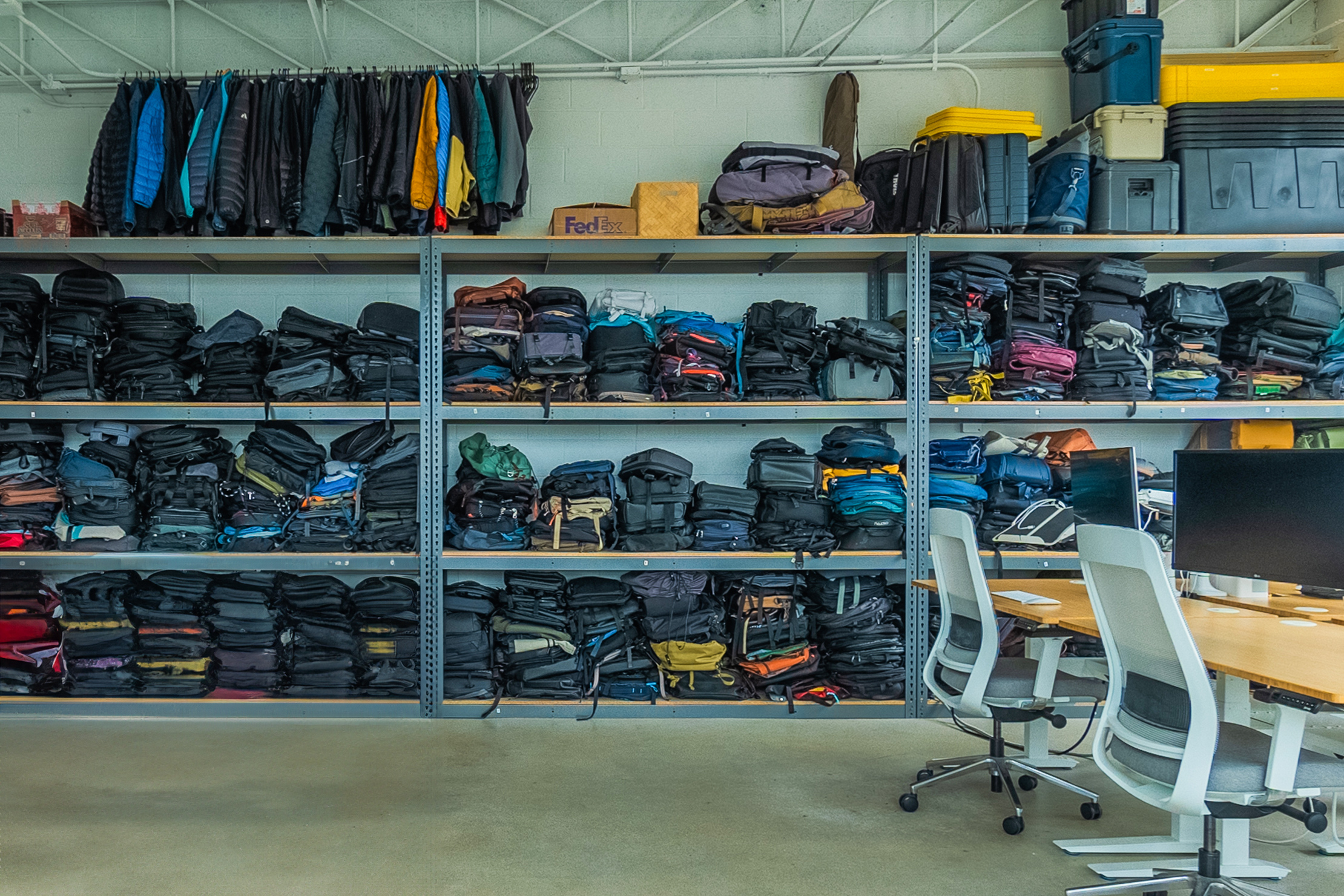
Our team is comprised of seasoned one-bag travelers who have been testing and reviewing travel backpacks since 2017. That means we’re using and testing these products every day to better understand what’s available out there and how each bag may appeal to different types of travelers. Each person has experience living out of a single bag while traveling the world, some for years at a time as digital nomads. When testing gear, we evaluate each backpack for a minimum of two weeks, putting it through the wringer on flights and commutes to our Detroit HQ alike. Each bag is then rated using our objective scale that allows us to compare its performance to other bags on the market. Additionally, we’re constantly updating this list as we review and rate new bags frequently.
How We Tested It
Each travel backpack we recommend in this guide is thoroughly tested and recommended by our team. We use each bag daily for a minimum of two weeks and take them on trips around the globe to put their carry-on compliance, organization, and durability to the test in real-world scenarios. While we cover the basic features of the bag in this guide, we also have full written and video travel backpack reviews for every top pick and hundreds of others that didn’t make the cut (but are still worth considering).
Decisions, decisions… Navigating the not-so-clear world of travel packs.
We’ve teamed up with CabinZero to give away a selection of top travel gear! Check it out →
Video Guide Part 2: Form
Feel free to watch this guide section in video format. We’ll keep the written content on this page up to date.
Be sure to subscribe to Pack Hacker on YouTube and never miss a video. We also have these videos in a series playlist format on YouTube so you can watch them easier.
Why Choose A Travel Backpack?
We’ve found that backpacks give you much greater mobility. You can breeze through airports. You’ll never stand around a baggage carousel after a long haul again. And as long as your pack is carry-on size compliant, you’ll never lose your luggage, ever. Depending on your travel style and what you’re hauling, it comes down to your personal preference—both roller bags and backpacks can be good options. If none of that sounds ideal and you prefer carry on luggage instead, we won’t judge (we review those, too). However, in this guide, we’ll focus on travel backpacks for a couple of reasons:
They Feel Freeing
You’ve got both of your hands-free, and you’re not constantly dragging something behind you. No matter what terrain you’re walking on, you’ll never have the annoyance of loud or unsteady wheels behind you from standard travel luggage. Sure, roller bags work like a charm on smooth airport and hotel floors, but how about the winding cobblestone roads of Paris or a sandy beach in Ko Pha Ngan? You can traverse almost any terrain when you’re wearing a backpack.
Best Travel Backpack | Traveling with the Osprey Farpoint 40 in India.
They’re Versatile & (Usually) Lightweight
If you pack light enough, you can comfortably have all of your belongings with you at once. Did you arrive earlier than your hotel or Airbnb check in? No problem, just take your pack around with you for the day—no need to stop by and drop your luggage off. Versatility at its finest.
Weight is about more than just your gear, too. While we can’t guarantee the pack will be lightweight if you fill it up with a bunch of heavy stuff (like a camera kit), it’s surprising how much you can fit into a travel backpack before it starts to hurt your back. Plus, with budget airlines cracking down on weight limits all over the world, you don’t have to worry about an 8-pound piece of luggage taking up half of your allowance, as travel backpacks often only weigh two to four pounds.
They Provide Flexibility
You’ll take up less room on the airplane or in public transit. You’ll generally feel more agile vs needing to drag around rolly luggage, with the added benefit of not looking like an out-of-place tourist. It caters to a more adventurous lifestyle by always being ready to go. And, you can easily catch that train that’s about to depart without awkwardly side-running with a roller bag or two.
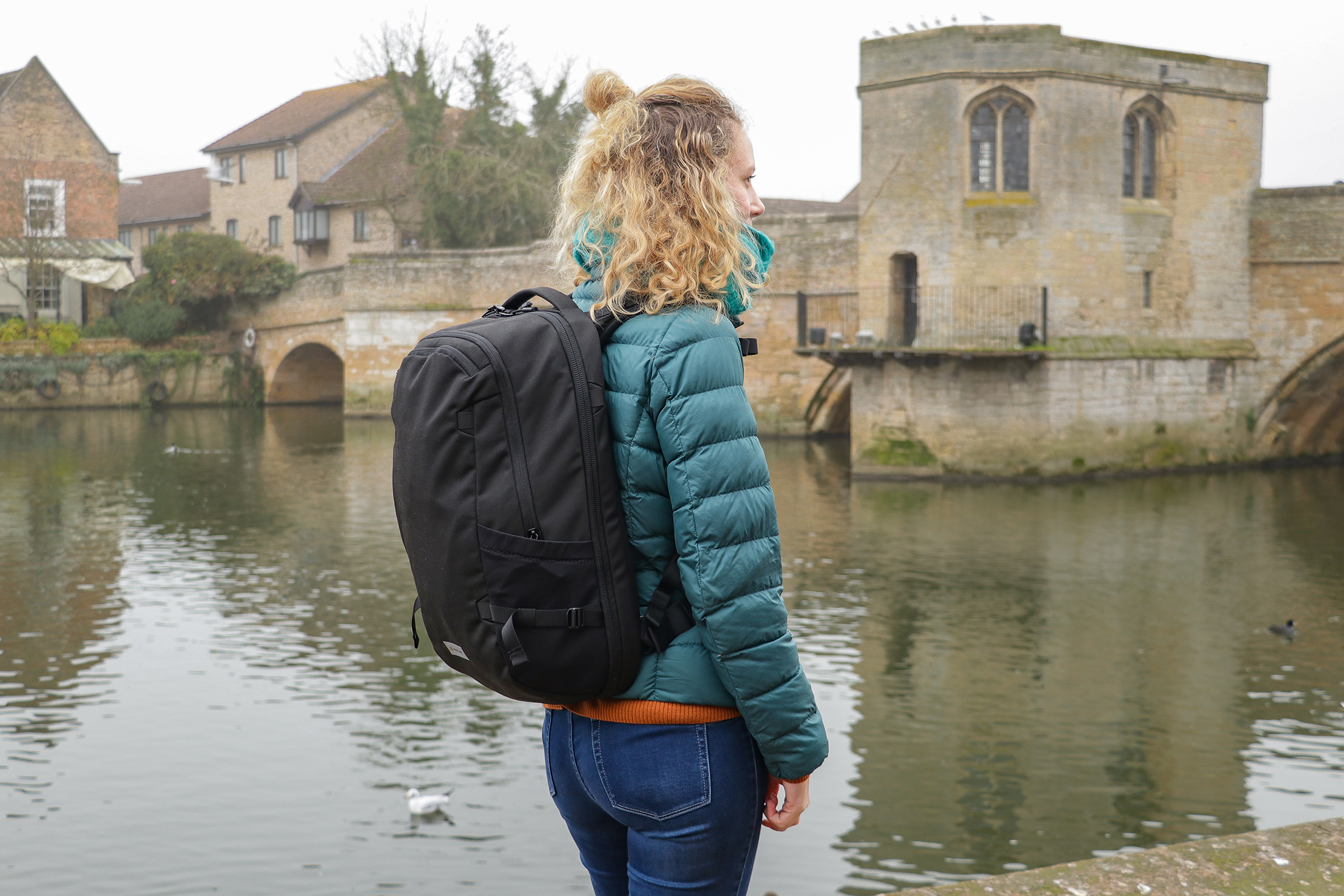
In this guide, we’re going for travel versatility. We want you to look good carrying these bags around in an urban environment and have the flexibility to head out on a hike for a couple of days of camping without having your backpack ruined by the elements. If you’ve got a piece of roller luggage, it’s going to be hard to do that spontaneous half-day trek on the trail to the neighboring city you’ve been wanting to check out. Likewise, if you’re going to post up at a coffee shop for a day of office work, you’re going to look out of place with a bulky, multi-colored hiking bag. The packs mentioned in this article will blend into most city environments and are durable enough to withstand the abuse of longer excursions.
Size & Weight for Carry-On Air Travel?
We favor smaller bags that fit in the overhead bin. Yes, it can be a challenge to fit your entire life into a 40L bag, but wow, is it worth it! Seriously, you could even fit everything into an 18L backpack if you’re disciplined. Life is just easier with a smaller & lighter backpack. That said, we highly recommend staying under 50L for one bag travel, so you don’t have to go too extreme. If you want to cheat a bit and get some extra space, you can also go the sling bag on the front, backpack on the back route.
Airlines can get pretty stingy around the amount of weight you can bring on board. It’s essential to make sure your backpack itself isn’t too heavy, or you won’t be able to fit in as much clothing and other travel gear. We’re all for less clothing and gear, but we are not for getting hit with extra fees if your carry-on is overweight. Starting out with a bag that’s already too heavy before you’ve packed it is just setting yourself up for failure! We calculate a carry-on compliance score for every travel backpack reviewed on our site using its dimensions and data we collect from most airlines worldwide.
True Volume
It’s easy to get caught up in all this talk around liters of a backpack. There’s really no “industry standard” around this, and the liter size of a pack can vary from brand to brand. For example, what one brand considers to be 40 liters may feel smaller or larger than what another brand considers to be 40 liters. What’s more important is the “True Volume” of a backpack and how usable the space is. Some weird, trapezoid-shaped backpack will certainly be more of a challenge than something with a larger, rectangular compartment.
The thickness and flexibility of the material matter as well. A thin, strong material will leave you with more space inside of a backpack than something with thick padding in the liner. However, a rigid material—Dyneema, for instance—doesn’t have much additional flex and isn’t very forgiving when you’re trying to pack your bag to the brim. The efficiency of space can make or break the usefulness of a pack.
Pack’s Exterior Profile
The profile of a pack can help out quite a bit. Not only does a slim bag seem less heavy because the weight is close to your back, but it has the added benefit of giving you a smaller form factor. With this, you won’t be taking up too much room on public transit or smacking people in the face when you’re boarding the airplane—it’ll be a better experience for you and everyone around you.
However, slim bags with large capacities often have longer back panels, which can feel unwieldy or uncomfortable on those with shorter torso lengths. We’ll cover how exactly to find the right fit in the next section.
Max Legal Carry-On
Otherwise known as “MLC,” Max Legal Carry-On size covers the largest acceptable backpack size for carrying on most airlines. Make sure to check with your airline before arriving at the airport, though—size limits can vary based on the airline you’re flying with.
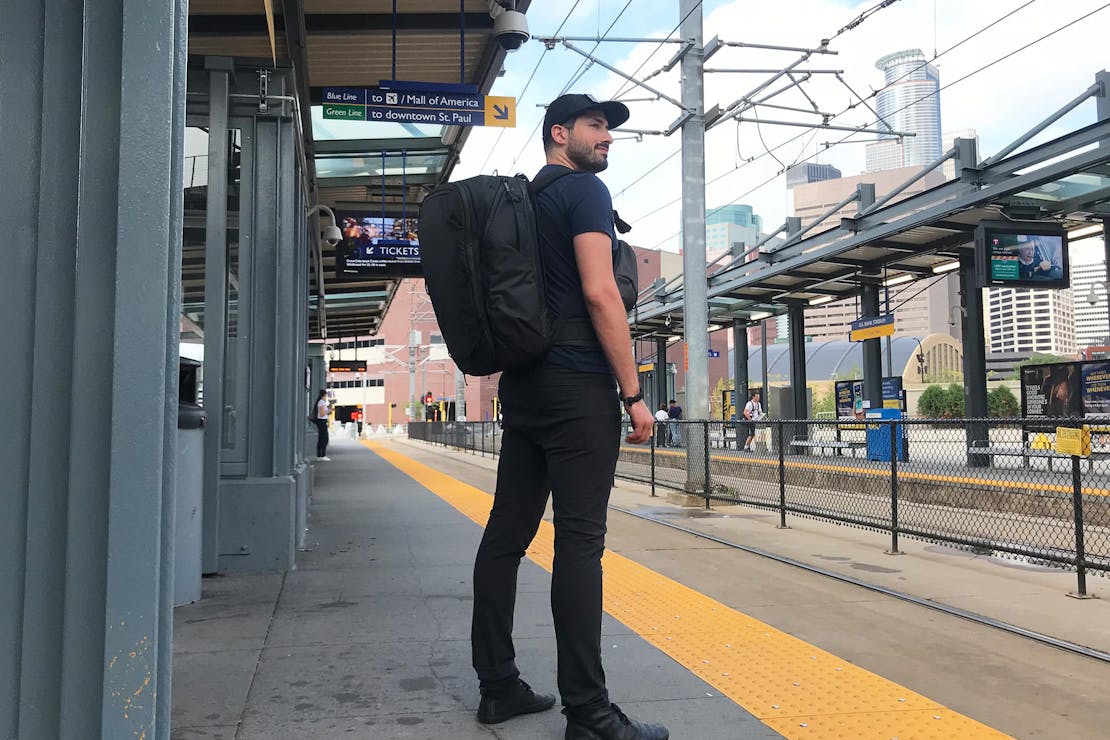
The Peak Design Travel Backpack is a well-executed travel bag from a company with an excellent track-record of bringing innovative and unique designs to the backpack world. This maximum legal carry-on can easily handle one bag travel, photography, or digital nomading with ease—and it will be a joy to use for any of those activities.
Top-loading vs Panel-loading (Clamshell) Backpacks
There’s a big debate around clamshell and top-loading packs. We’re personally a fan of clamshell for one-bag travel, as it gives you better visibility of your gear.
Clamshell functions more like a suitcase and opens literally like a clam. You can easily open it up flat and see everything inside, so it tends to be easier to organize all your travel gear.

The Able Carry Max Backpack is a clamshell-style backpack that opens to give you easy access to a spacious main compartment—this works great for packing cubes or rolled up clothing—whichever you prefer! Also, it’s got a large but low-profile water bottle pocket.
Top-loading packs are great if you’re on a long, multi-day trek or participating in other outdoor-focused activities. They often feature a rolltop opening instead of a zipper, which adds weatherproofing and peace of mind, as there’s no main zipper that can fail you (which could be catastrophic if you’re halfway up Mt. Everest). However, you’ll have to pull out everything on top to get to gear on the bottom, which isn’t convenient if you’re in the middle of the airport. Some bags have a creative solve for this, though.
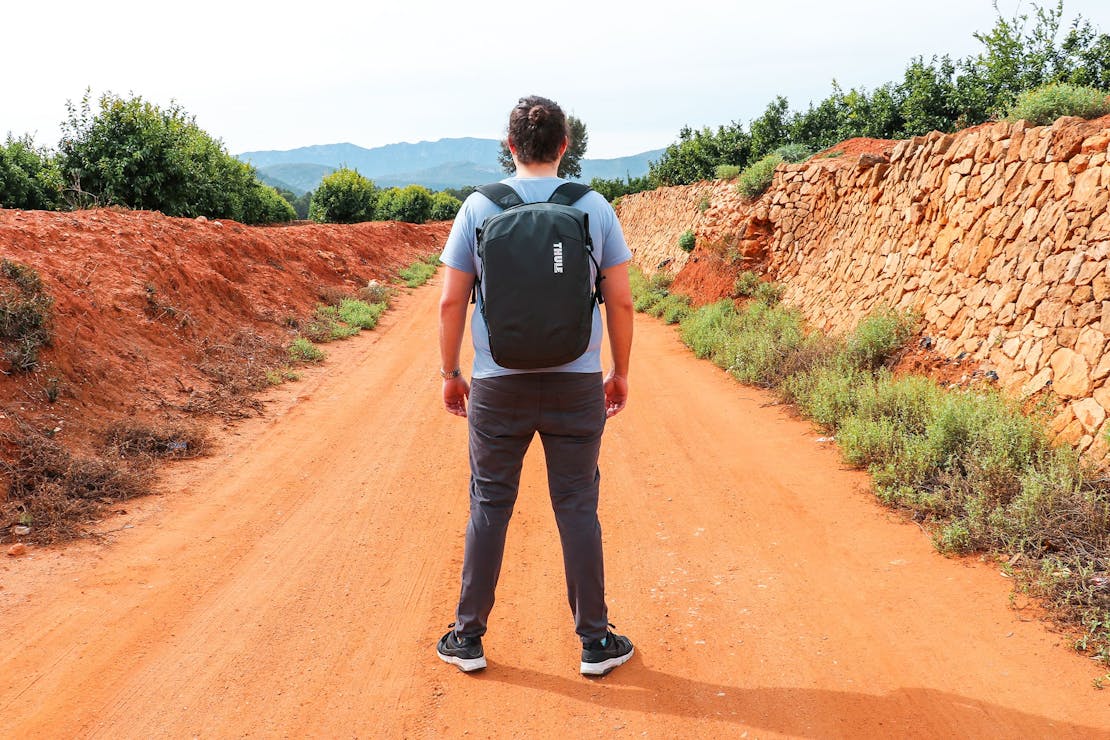
The Thule Subterra 34L is a top-loading backpack with a roll top opening. A top loader’s usual pitfalls are fixed by an easy to access side zip that allows entry to the main compartment. This zip comes in handy when you don’t have time to mess around with the roll top, or you want to grab something located at the bottom of the bag.
Weather Resistance
Best Travel Backpack | The GORUCK GR2 features “weather resistance” but it’s not “waterproof.”
Weather resistance is another key component to consider for one bag travel. With all your tech gear and expensive possessions in your pack, you don’t want moisture to seep through. We look for packs with some great weather resistance that’ll easily get you through light rain and ideally through 20 minutes of a monsoon in Southeast Asia.
Now, for the most important note of all: there’s a big difference between waterproof and water-resistant bags. We’re mainly focused on the latter, as this will be plenty in most situations. Sure, waterproof is more secure, but unless you’re leaving your pack outside in a torrential downpour for hours on end or plan to go snorkeling with your laptop on your back, there’s no need for that extra tech. Look for bags that have a DWR (Durable Water Repellant) coating, and you’ll be fine.
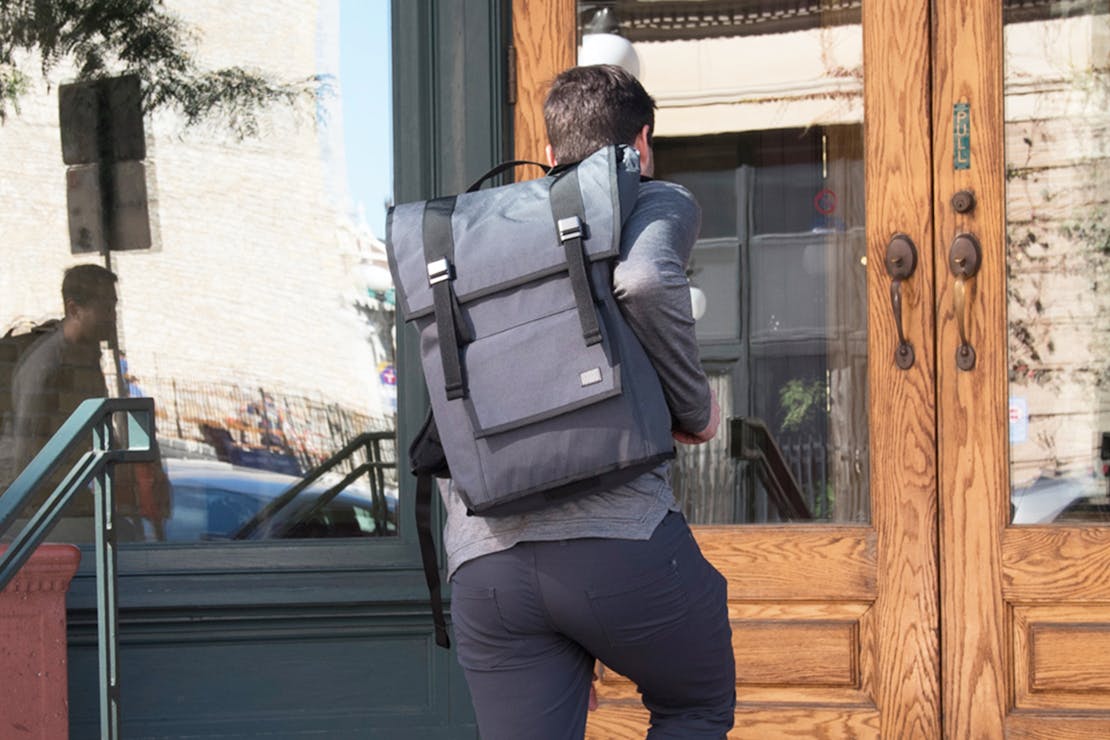
The Mission Workshop Fitzroy VX utilizes weatherproof materials and weather-resistant zippers. We’ve found it to hold up decently in a downpour. Even if you’re caught in a pretty torrential rainstorm, you should be okay with the PET waterproof membrane.
Got something that needs some additional weatherproofing? Consider picking up something like a DAKA Pouch. It’ll give your valuables that extra layer of protection without requiring you to purchase an entirely waterproof bag—plus, these pouches double as organizers, separating your precious gear from the rest of your loadout with some additional protection to boot. It’s a win-win.
Durability and Quality
Whether you’re traveling for a week, a month, or a year plus, your backpack is pretty much your home, so you don’t want it to break. Take it from us—the last thing you need is to find out that you lost your phone charger (or passport!) because the zipper head came off its track during the journey to your next accommodation. Investing in a good backpack will prevent loss and damage to your gear, and higher quality products will last for several years. It can be a challenge to tell if a backpack is durable right out of the box, which is why we test bags as much as possible to notice any faults. Higher durability usually means higher weight, but not always. Here are a couple of key considerations when it comes to durability.

When it comes to durability, the Topo Designs Travel Bag 40L doesn’t mess around. The 1000D nylon, beefy YKK #10 zippers, and simplistic design all come together to create a bag that won’t let you down.
Zippers
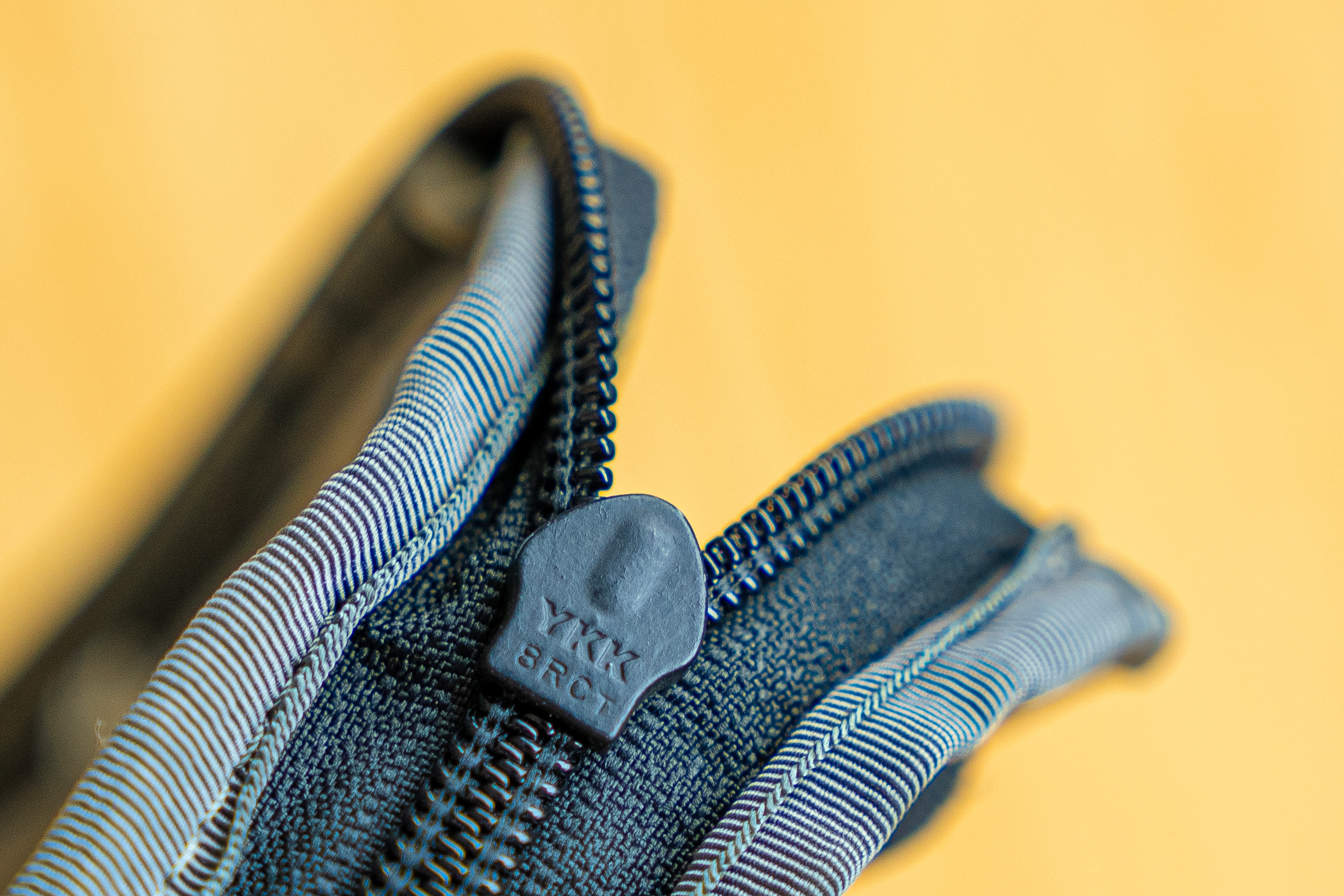
YKK zippers are some of the best around, so naturally, the best travel backpack brands tend to use them. They’re super strong and have different weights depending on where they’re located on the pack. A YKK #10 will keep a main compartment secure, whereas a YKK #5 may be suited for smaller side pockets that don’t receive as much use or tension. As they go up in weight, they also go up in size, so be prepared for beefy zippers to have a beefy look.
YKK is obsessed with quality, and they do everything in-house. They smelt their own brass, forge their own zipper teeth, and even make the machines that make their zippers and the cardboard boxes they ship in! YKK zippers also account for about half of all zippers in the world, so that says something.
Although less popular, RiRi zippers are pretty great too. Both RiRi and YKK are superior to any other zipper made in-house by a bag manufacturer, and Zoom Zippers are climbing up on that list as well, though we still find intermittent issues with them.
How do you find what zipper your bag has, you ask? Most quality brands will list it under the product specifications on their site, but you can also inspect the bag itself once you have it in hand. Check the side and underside of the zipper head or zipper pull for the letters (YKK for YKK, Z for Zoom, etc.). If you’re still unsure—or haven’t purchased the bag yet—we check for the brand on every bag we test and indicate it in the review. If we’re not 100% sure, we contact the brand directly and ask!
Backpack Fabric and Material
There are a ton of materials out there, too. When looking at fabrics, you’ll often see a number followed by a D—250D, 950D, 1500D, etc. The D stands for denier, a term used to measure the fabric’s thickness and weight, specifically the yarn. The formal definition is the mass (in grams) per 9,000 meters of fiber, so lightweight fabrics (like silk) have a very low denier, while heavier fabrics have a higher denier. When it comes to backpacks, a higher denier is not necessarily better. In general, a higher denier will be more durable (depending on the fabric and weave) but also heavier. While the denier can tell you the weight and thickness of a material, the type of material, weave, and manufacturing involved will ultimately tell you more about its strength and durability. Here are some materials you’ll come across when selecting your pack, along with the pros and cons of each.
Ripstop Nylon

Pretty close in property to standard nylon, “ripstop” nylon has a unique square weave that prevents further tearing from happening after a puncture. It has an incredibly high strength-to-weight ratio, and, as the name implies, it is highly resistant to rips and tears. The reason why it’s so strong is that additional fibers are sewn into the weave. While it generally has an outdoorsy look because of the visible square pattern, some designs hide this better than others. Ripstop Nylon was developed in World War II as a more robust alternative to silk parachutes and is currently used in ejector seat parachutes for fighter pilots!
Ballistic Nylon

Ballistic Nylon refers to any nylon fabric with a “ballistic weave,” a variation on the simple basketweave. This gives it excellent tensile and tear strength—especially when layered—and makes it heavier than a lot of other materials. Keep in mind that ballistic nylon almost exclusively comes in black. Why is it called ballistic? It was initially used on flak jackets for World War II airmen to protect them from artillery-shell and bullet fragmentations. PSA: We do not recommend the use of backpacks for protection in war zones.
CORDURA® Nylon

CORDURA® is not a fabric in and of itself—it’s a brand covering a whole host of different materials, from cotton to nylon to polyester. They take fabric from various mills, inspect it to make sure it’s up to their standards, and then slap that CORDURA® tag on it. Yes, it’s a bit deceiving, but they do put out some high-quality stuff. You’ll mostly always see a “®” next to “CORDURA” (in all caps) because #branding and #lawyers.
Kodra Nylon

Kodra is virtually synonymous with CORDURA® but made in Korea. Peak Design opted for this in the first iteration of their Everyday Backpack.
Polyester

Polyester is one of the most common fabrics on the planet. It’s made from plastic fibers, and you can find it pretty much everywhere—in clothing, pillows, seat belts, upholstery, rope, the list goes on … Oh, and backpacks. Polyester is not the most durable fabric, so you’ll usually find it on lower-end packs (think of those classic Jansport backpacks everyone had in high school). It’s not the most suitable choice for a travel pack, as it just won’t hold up through the years. Besides lacking in durability, polyester is also fairly heavy compared to other fabrics like nylon. If you’re looking for a low-budget day pack, polyester is fine. If you’re looking for something more serious, stay away from it.
Polypropylene

Polypropylene is a polymer that is used to make fabrics. This stuff is seriously everywhere—it’s the world’s second most widely produced synthetic plastic! It’s used to make ropes, carpets, labels, plastic lids on tic-tac containers, plastic chairs, long underwear … basically, if you see something made of plastic, there’s a solid chance there’s some polypropylene in it. You’ll find it mostly in minor backpack components, but it’s also used to make drawstring bags and totes like the ones that are handed out for free at a college fair or festival.
Polypropylene fabric has a few things going for it. It’s cheap, it’s a good insulator because it doesn’t transfer heat very well, and it won’t absorb water since it’s hydrophobic. The major problem with polypropylene is that it is not very UV resistant. If it’s repeatedly exposed to sunlight, the fabric will fade and break down over time. This is not great for backpacks. You may, however, see polypropylene used as a liner on the inside of some packs as it won’t be affected by UV light and adds some additional protection.
Canvas

You could say that canvas is the OG backpack material. Back in the day, canvas was just about the only thing you would use for a “backpack,” outside of maybe a burlap sack thrown over your shoulder. In World War II, GIs carried all their equipment around in canvas packs and slept in canvas tents. Canvas is very thick and sturdy and historically made from cotton, linen, or hemp coated in wax for waterproofing. Today, canvas tends to be made from things like nylon and polyester. Most modern backpack companies shy away from canvas because it’s usually heavy, not overly water-resistant, and easily damaged by abrasion. If you’re looking for a canvas one-bag travel pack, you won’t find much out there. However, if you want the nostalgia factor, you can still find a bespoke canvas bag to satisfy that.
Leather

We may need to scrap our statement on canvas because leather is arguably as OG as it gets. Its use has been traced back as far as Ancient Greece and Rome! Like canvas, you’re not going to see many travel backpacks made of leather. While a leather bag can make for an excellent, stylish daypack, it’s not ideal for a long-term travel pack, mainly because of its weight. There is also a lot of potential care involved. Between protective oils and various cleaning techniques, it can be a hassle to deal with if you’re on the move.
There are three grades of leather: genuine, top-grain, and full-grain. Contrary to popular belief, genuine is the lowest grade of leather while full-grain is the highest. Full-grain is used for heavy-duty use cases like weapon holsters and work belts, so if you’re dead set on a leather pack, we recommend looking for full-grain leather. Ideally, you’ll want to find something thin enough not to be overly heavy while still thick enough to ensure durability.
Sailcloth

The actual material is called ultra-high-molecular-weight polyethylene … but most know it as sailcloth (yep, the same material used on a sailboat). A relatively rare material for backpacks, brands like Tortuga have taken advantage of sailcloth due to its lightweight and water-resistant properties. It is by far the most lightweight and waterproof material on our list (no need for DWR or liners), but it does have some drawbacks. It’s stiff and crinkly with zero stretch, which can cause problems if you’re trying to utilize every nook and cranny of your pack. It isn’t quite as indestructible as some other materials listed, but it’s reasonably durable and can be patched. It also tends to be one of the most expensive backpack materials out there.
Dyneema® Composite Fabric

In May 2015, Dyneema purchased Cubic Tech, the creator and manufacturer of Cuben Fiber, and rebranded it as Dyneema® Composite Fabrics. So, Dyneema® Composite Fabrics = Cuben Fiber. This stuff was initially designed for high-tech sails on racing yachts because it is ridiculously light and robust. It’s sort of like the carbon fiber of the backpack world—high-tech, super strong, super light, and … super expensive. While Dyneema® Composite Fabric is popular within the ultralight backpacking community, it has yet to become commonplace in the one-bag travel scene. That said, if you do see Dyneema® Composite Fabric, you should know that you’re getting some of the best stuff around.
X-Pac

X-Pac is not so much a fabric as it is a bunch of fabrics smooshed together. With the help of lamination technology, complementary materials are combined to make an overall higher-performing product. Though there are variations in denier and waterproofing, it’s most commonly made up of a nylon face for durability, polyester mesh for strength, and waterproof film that won’t disappear over time. Like Dyneema® Composite Fabrics, it was inspired by the efficiency of sailcloth but is a less costly option that provides a similar level of ultralight performance. It holds its shape over time, won’t fade with UV exposure, and easily sheds moisture, making it great for outdoor enthusiasts who hike and bike with their packs on the regular. While more brands are making X-Pac options of their popular bags available, it may be a bit overkill for casual travelers unless you’re looking for a backpack for epic mountain climbing adventures.
TPU

Thermoplastic polyurethane—TPU for short—is a polymer used to add strength to a material, either through a manufacturing process or coating. You’ll recognize it on products like inflatable rafts, phone cases, wire cables, and footwear. Think stuff that needs to be as durable as possible to avoid things going south for the user. It easily sheds water and oil, resists abrasions, and won’t crack in high or low temps, making it ideal for frequent outdoor use. Unlike polypropylene, TPU is UV-resistant and won’t be subjected to the same amount of fading over time. If you’re the type of traveler who wants extra peace of mind on the go, you’ll want to keep an eye out for TPU because of the extra strength it adds to a pack, but we wouldn’t consider a lack of TPU a deal-breaker.
Putting It All Together
Ultimately, the production process and design will dictate whether your gear’s durability. If a bag is made with 1000D CORDURA®, but it doesn’t have good zippers to match, it doesn’t matter how good the fabric is. Look for brands that proudly back their product with generous warranties, like GORUCK and their “SCARS warranty” or Patagonia and their “Ironclad Guarantee.” These brands know they make quality products, so they’re happy to back it up. If a brand offers no warranty or a short warranty, there’s probably a financial reason for that, and the quality may not be as high. We’re all about buying quality pieces that last versus something that’s going to need repair or replacement year after year.
Whether you’re hopping on a plane or navigating city streets, you need a backpack that can hold up.
We’ve teamed up with CabinZero to give away a selection of top travel gear! Check it out →
Video Guide Part 3: Function
Feel free to watch this guide section in video format. We’ll keep the written content on this page up to date.
Be sure to subscribe to Pack Hacker on YouTube and never miss a video. We also have these videos in a series playlist format on YouTube so you can watch them easier.
Best Backpack for Comfortable Wear and Extended Travel
Comfort is a big deal when it comes to one-bag travel—especially if you plan to carry the bag around with you for hours on end. You’ll want a high-quality harness that works with the shape of your body. When selecting a bag, it’s crucial to take your height and body type into consideration. Although this matters more for hiking backpacks where you’re carrying a ton of gear, it’s less important for smaller, one-bag travel packs. That doesn’t mean you shouldn’t think about it before you make a purchase. A backpack suited for someone that’s 6’5″ and 250 pounds probably isn’t the best travel backpack for someone that’s 5’3″ and 140 pounds. Buying something that doesn’t fit your frame correctly will make for some seriously uncomfortable travel.
Men’s Focused Fit Vs Women’s Focused Fit
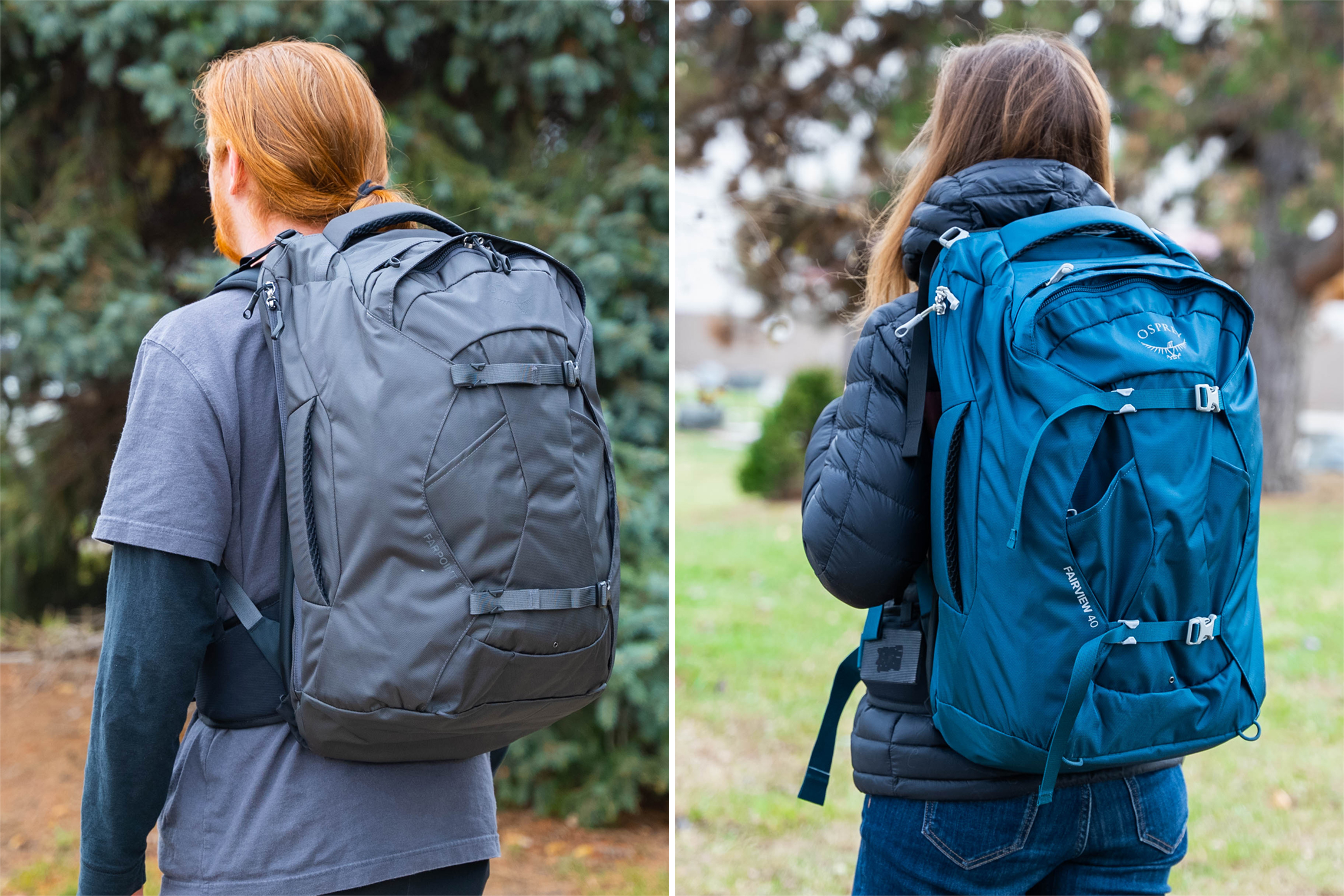
Some backpacks are only available with a “one size fits all” harness system. However, while users can tweak their way to a relatively comfortable fit by adjusting the straps, backpacks designed for different body types can cater to more users. This is why you’d sometimes find travel backpacks for women and for men sharing the same name. Two fits, similar designs. For example, the Thule Landmark 40L and REI Ruckpack 40 are available in men’s and women’s fits. The differences are subtle but have a big impact on how comfortable the harness system is on your frame. Compared to a men’s focused fit, a women’s focused fit backpack will typically feature:
- Thinner shoulder straps for a narrower frame
- Shorter shoulder straps that position the bag higher up the back
- Smaller hip belt with a more pronounced curve
- A shorter back panel to accommodate smaller torso lengths
Torso Length
Knowing your torso length will help you find a travel backpack that’s comfortable even when it’s packed to the brim with gear. Your torso length is defined as the distance between your C7 vertebra and iliac crest. For those of us who aren’t well-versed in anatomy (join the club), that’s the very base of your neck to the top of your hip bones when measuring directly down the spine.
This measurement usually ranges between 15-17″ for adult women and 17-19″ for adult men. Of course, taller women may have a longer torso, and shorter men may have a shorter one. Additionally, tall adults can have a short torso (if you’ve ever been told you’re “all leg,” this may be you), and vice versa. That’s why we recommend measuring regardless of your height or gender.
Once you know your torso length, it’ll be easier to find a bag that fits before you even hit the “Purchase” button. The best brands will provide you with a backpack’s ideal torso range on their website (some are even adjustable!), but if not, you can look for women-focused or men-focused bags to accommodate your needs.
Back Panel
A well-designed back panel can make things much more comfortable. Although it’s hard to avoid the old sweaty back with extended periods of wear in hotter climates, well-ventilated mesh and foam help add airflow.
Additionally, the back panel shape impacts the bag’s ergonomics. Some travel backpacks (and even travel daypacks) have a frame sheet inserted into the back panel to help maintain its structure no matter how full the bag is. This means you won’t feel your gear poking through when the bag is stuffed, and it won’t feel saggy when the bag is empty. Travel backpacks often utilize plastic for their frame sheets because it’s lightweight and flexible, while hiking bags commonly use plastic sheets with aluminum stays (aka rods) since the bags are bigger and the gear is heavier.
Or, in lieu of a frame sheet, brands will often hack the fit by providing extra features on the backpack straps or harness system.
Backpack Straps
You’ll want to look for bags with high-quality straps that work for your body type. A mismatch here could lead to an uncomfortable carry, even with only a little weight inside.
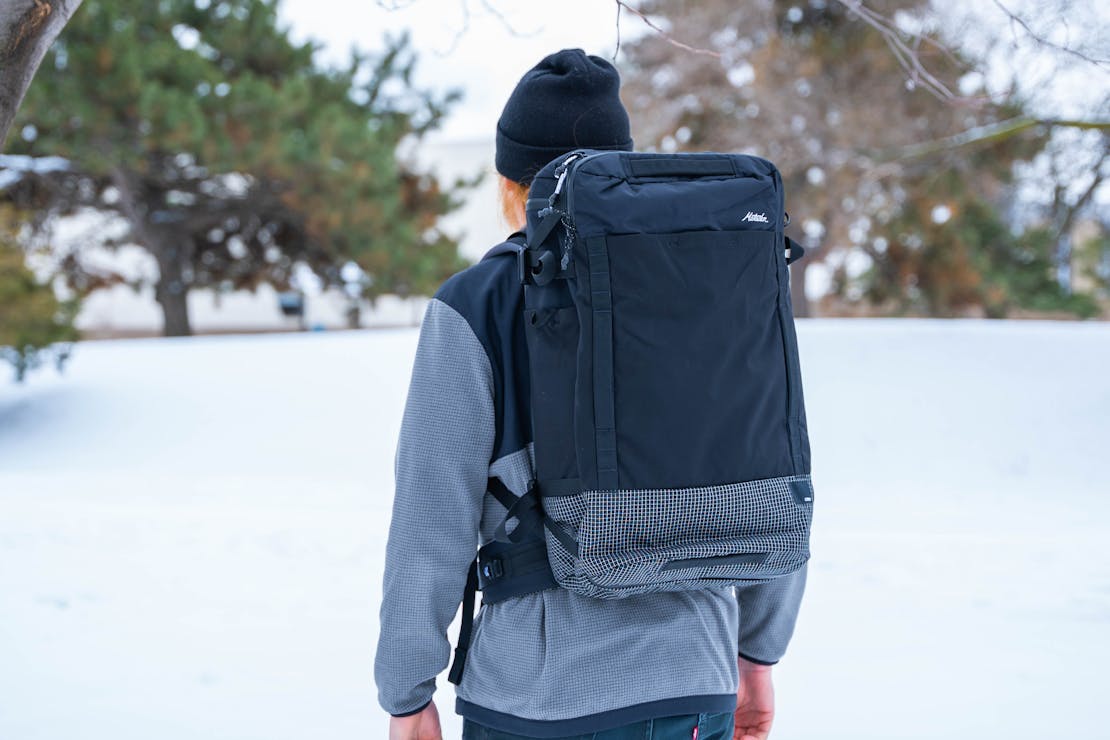
Even though the GlobeRider45 has the functionality and looks of a travel backpack, it carries more like a daypack. Its shoulder straps feature dense padding that curves and falls naturally to the body. A relatively high top area does give it a very slight hiking backpack feel, but it’s an overall tameable bag to travel with, considering its 45-liter storage capacity.
The thickness of straps doesn’t necessarily matter. Thinner straps that use high-quality foam may be more comfortable than thicker, bulkier straps.
If you’re concerned with weight, look for bags that include load lifters. These are the adjusters that appear at the top of the straps and pull the weight of the bag closer to your center of gravity. This concept is borrowed from larger hiking backpacks and does wonders for fitting the bag well to your back with different loads.
Some straps swivel and pivot to cater to different shoulder widths and make it easier to quickly flip the pack around to access the goods you’ve got inside.
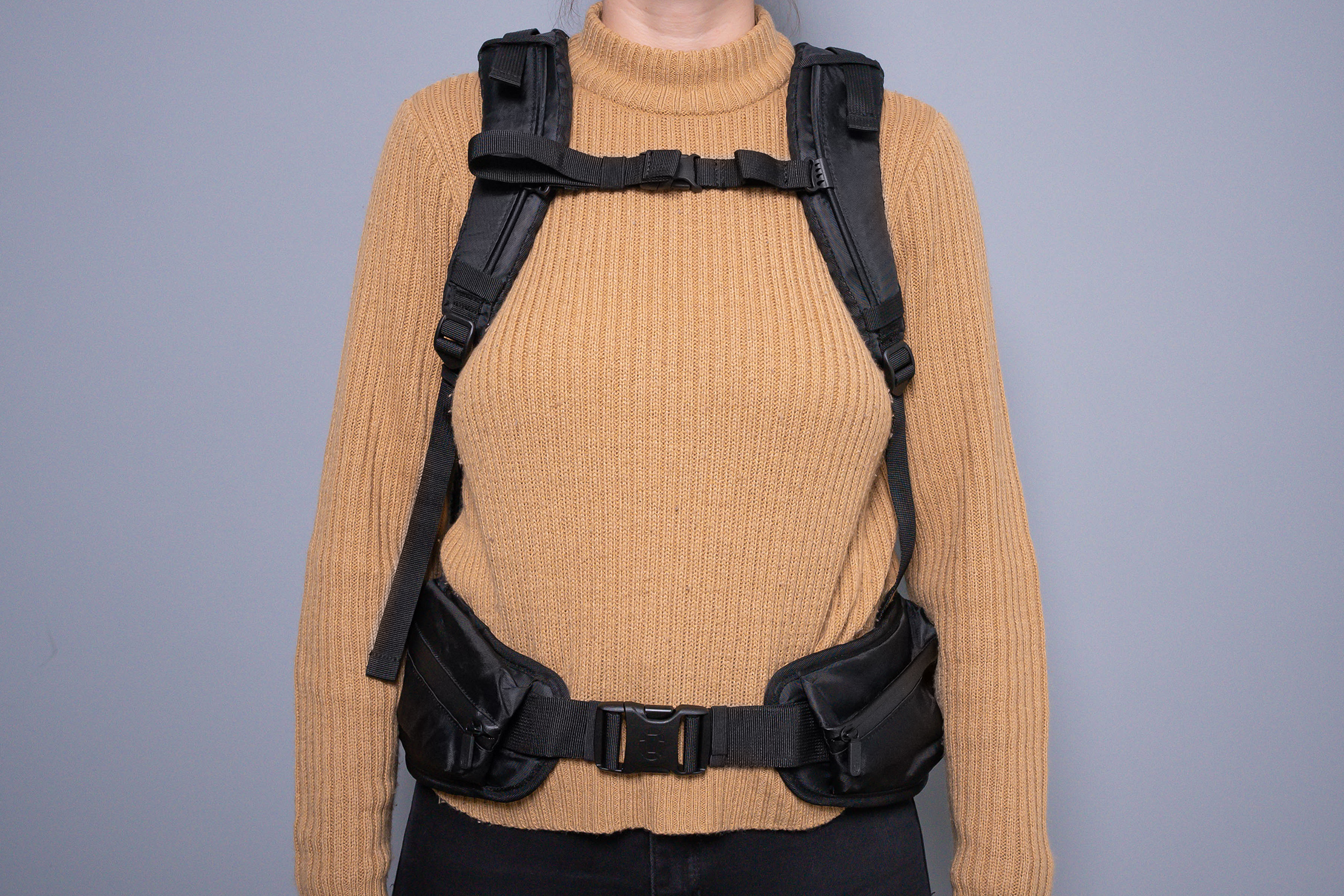
Hip Belts
We’re middle-of-the-road on hip belts for one-bag travel backpacks. They can help a ton if you’ve got a heavier load or plan to carry your pack for long stretches but aren’t necessary if you pack minimally in a smaller bag.
A good hip belt should be comfortable and secure without becoming too cumbersome. There are few things worse than hitting people with your bulky hip belt while walking down the aisle of an airplane. We’d recommend taking a look at travel backpacks that feature a detachable or hideable hip belt, so you don’t have to use it when you don’t need to.
Sternum Straps
Nearly all travel backpacks include a sternum strap. They’re designed to distribute some weight away from your shoulders and secure the shoulder straps across your chest. While sternum straps are all pretty similar across the board, there are a couple of things we’d recommend looking out for.
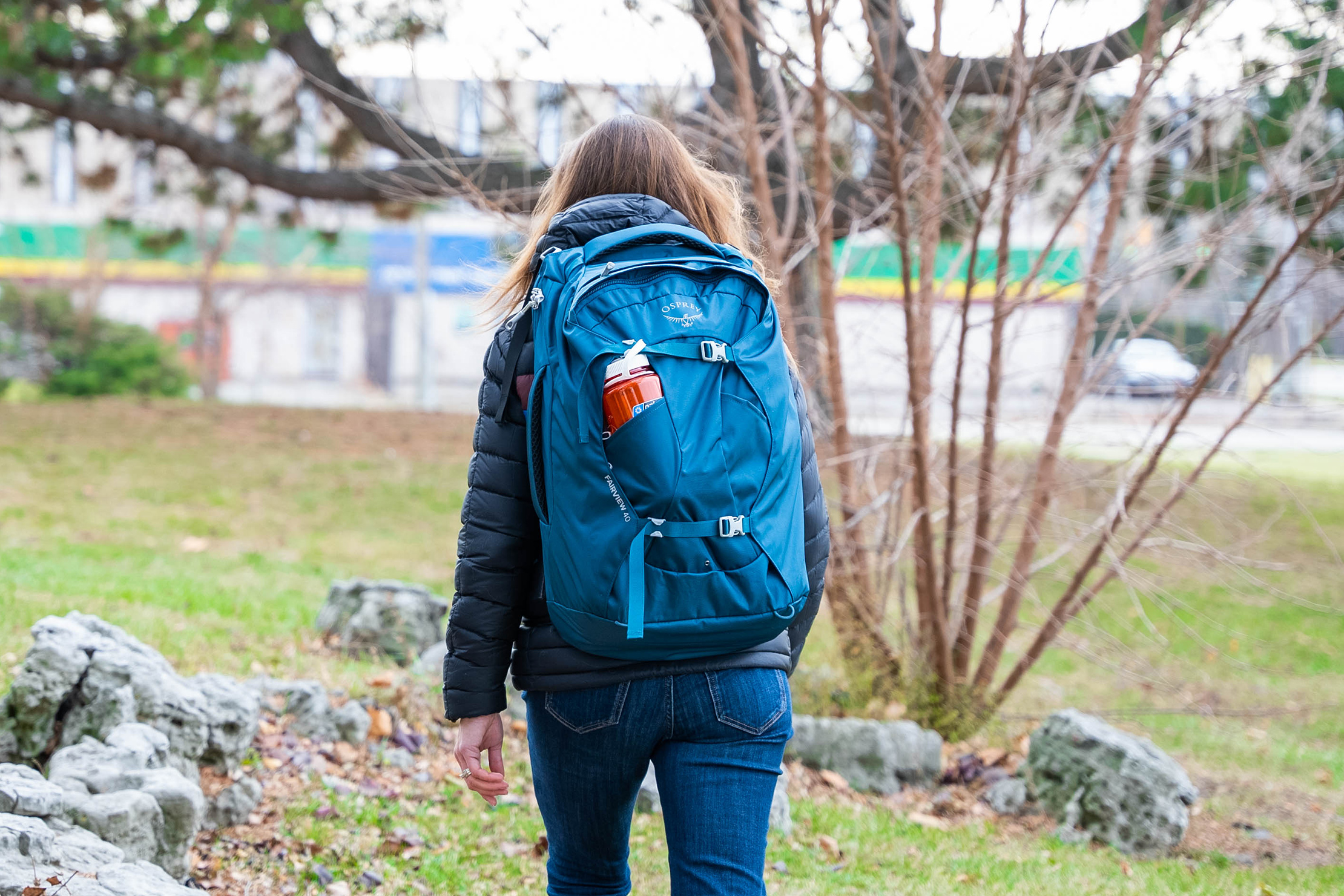
First, some will feature an elasticated portion that allows the strap to flex with your body as you walk. We’re big fans of these because then we don’t have to adjust the fit throughout the day.
Second, pay attention to how they attach. Some are on a rail, meaning you slide the buckles up and down, while others hook on via individual loops going up and down the shoulder strap, meaning you have to remove and re-insert them to make the buckle fit higher or lower. It ultimately comes down to personal preference, but we like the rail system because it allows for micro-adjustments to the fit and is less tedious to move overall.
However, rail straps are often not removable, which leads us to our third point. All sternum straps attached via loops can be detached if you don’t want them. However, this also leaves them vulnerable to falling off when not in use. We’re not kidding; this has happened to us on multiple occasions. Just make sure it’s secure and adequately anchored to the shoulder straps.
How Do you Pack a Travel Backpack?
With all these fancy features, it’s essential to consider how you should use them and how you pack your bag. Generally speaking, you want to load the heaviest items closest to your back and toward the middle of your torso. This’ll ensure the heaviest bits of your bag are the closest to your center of gravity, pulling you down less from the back of the bag.
Best Travel Backpack | Configuring a backpack.
If you’ve got all the features mentioned above, you want to strap and tighten your hip belt first, then adjust the shoulder straps, then tighten the load lifter straps (the straps on top) to a 45° angle, and finally, adjust and tighten the sternum strap.
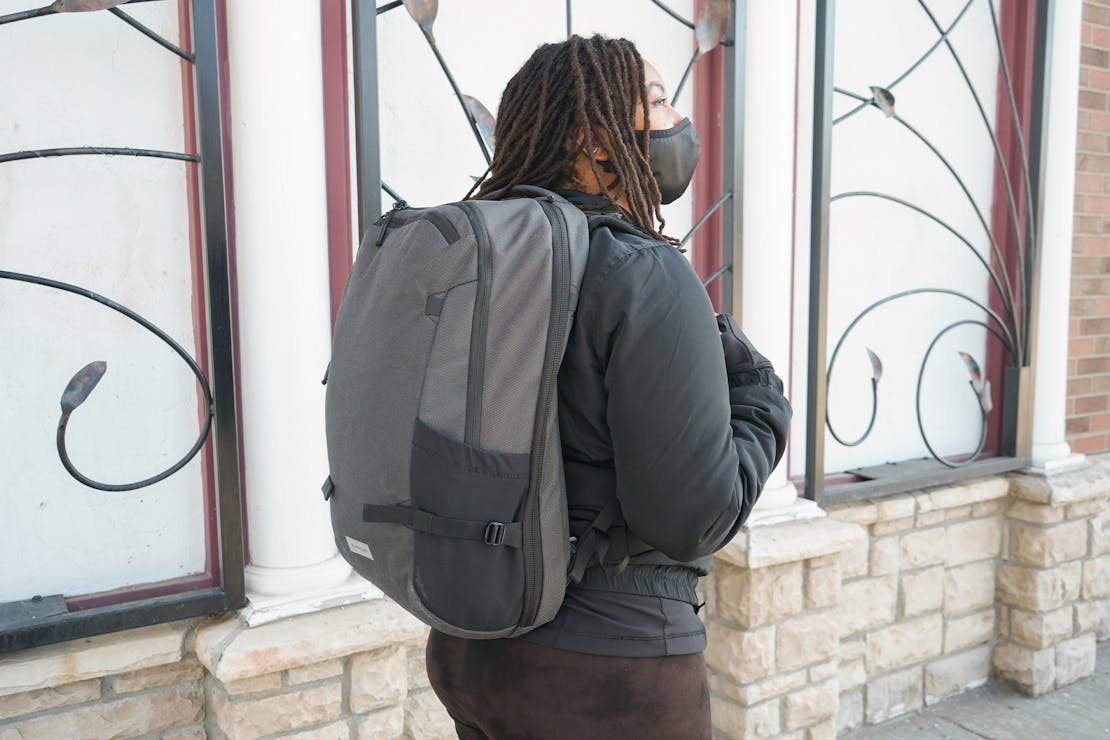
The Heimplanet Travel Pack 34L (V2) has a horseshoe zipper at the top front of the pack, which opens up to allow you to reach into the main compartment and grab essential items rather than opening up the full clamshell. It also features liter independent compartments and pockets, which are great for packing to the absolute limits. Check out the smaller 28L version, too.
Modular Backpack System
If you want more options for customization, check out modular gear. To put it simply, this is gear that brands design to work with their bags. They allow you to make a bag suit your preferences, adding and swapping parts as needed instead of trying to fit your gear into the organization already installed in your pack. Anyone who uses a bag with PALS webbing, for example, will tell you how convenient it is to have loops ready where they can stick MOLLE accessories. Whereas PALS webbing and MOLLE attachments are one of the better-known standards out there, brand-specific modularity and attachment systems also exist.
In fact, some brands, like ALPAKA, TOM BIHN, Boundary Supply, and Roark, are known for it. We like to count how many O-rings we can find on each TOM BIHN bag we buy because that’s where we can clip the brand’s key leashes, admin pouches, packing cubes, and more. Meanwhile, some bags have entire accessory systems built into the travel backpack design.
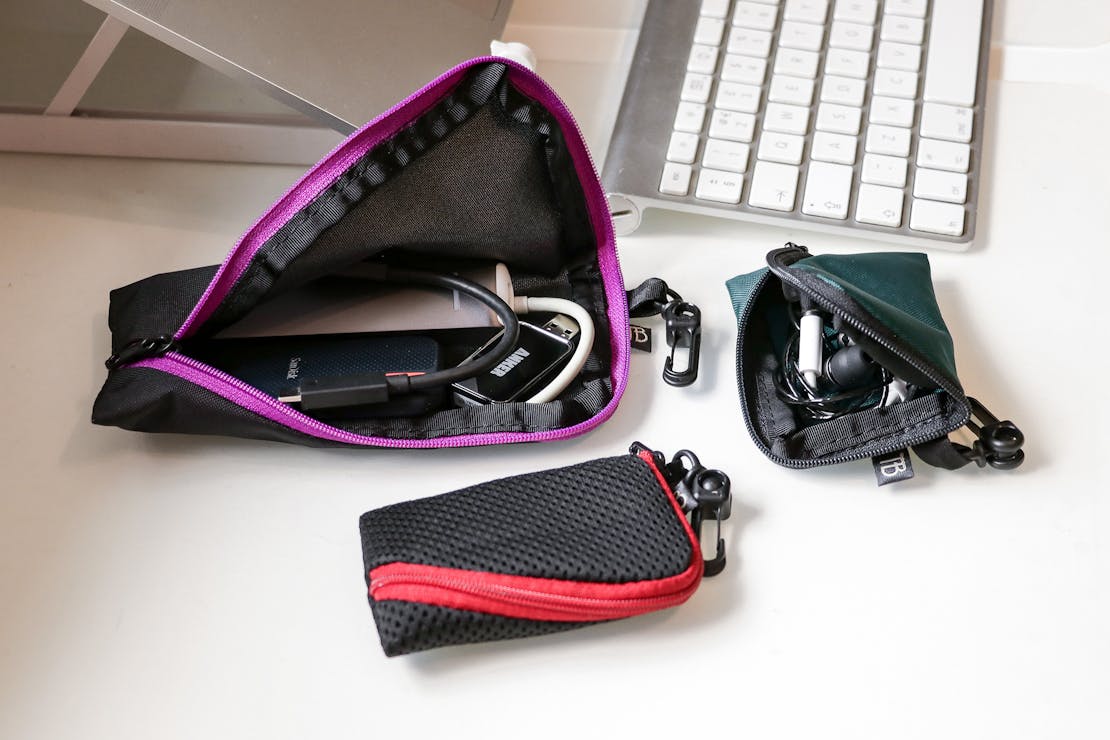
These great for carrying tiny travel accessories wherever we go. Sizes range from Super Mini, which can hold AirPods, chapstick, and similarly sized items, to A5, which is big enough for an A5-size notebook and pens. They’re made from scrap fabric, so you can feel good about saving them from the cutting room floor. They clip to the O-rings in a TOM BIHN bag or a loop on another backpack to save you from digging for small gear.
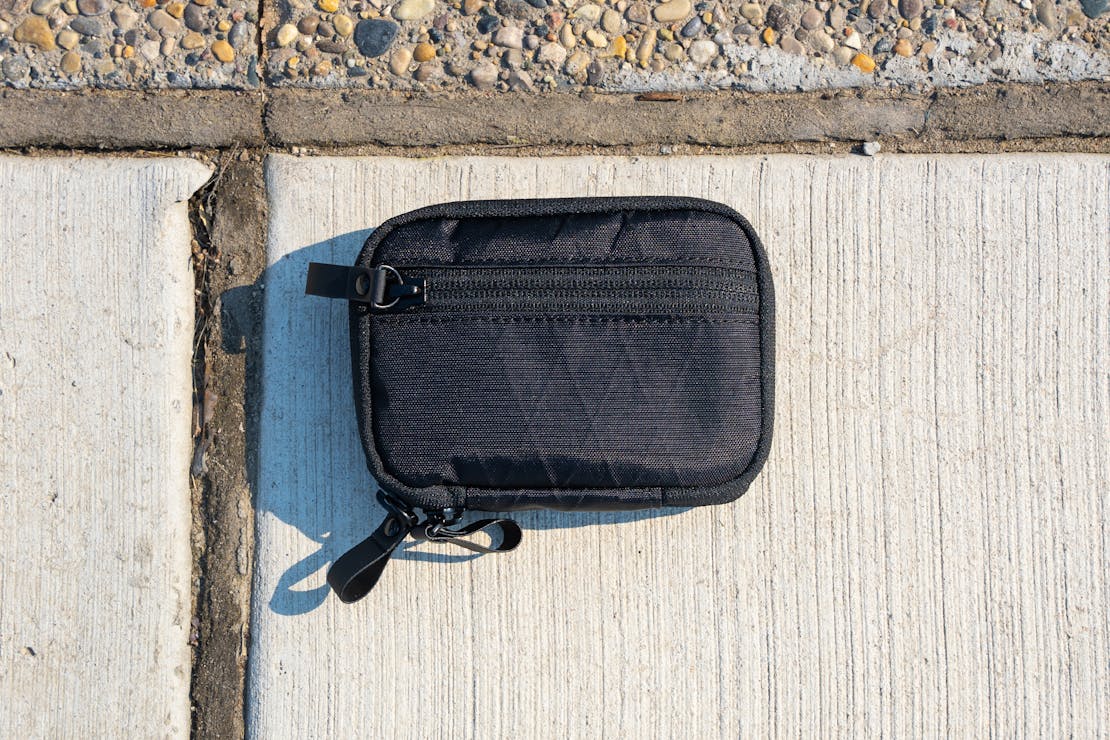
ALPAKA’s HUB Ecosystem lets you swap accessories like key organizers, hand sanitizer containers, card holders, and more between your bags. Pull the Hypalon tab to release the magnetic fastener to swap your gear, then attach it to different points throughout their bags or the HUB ModPanel hanging in your house. Then you’ll always know where your accessories are, and you can grab-and-go with ease.
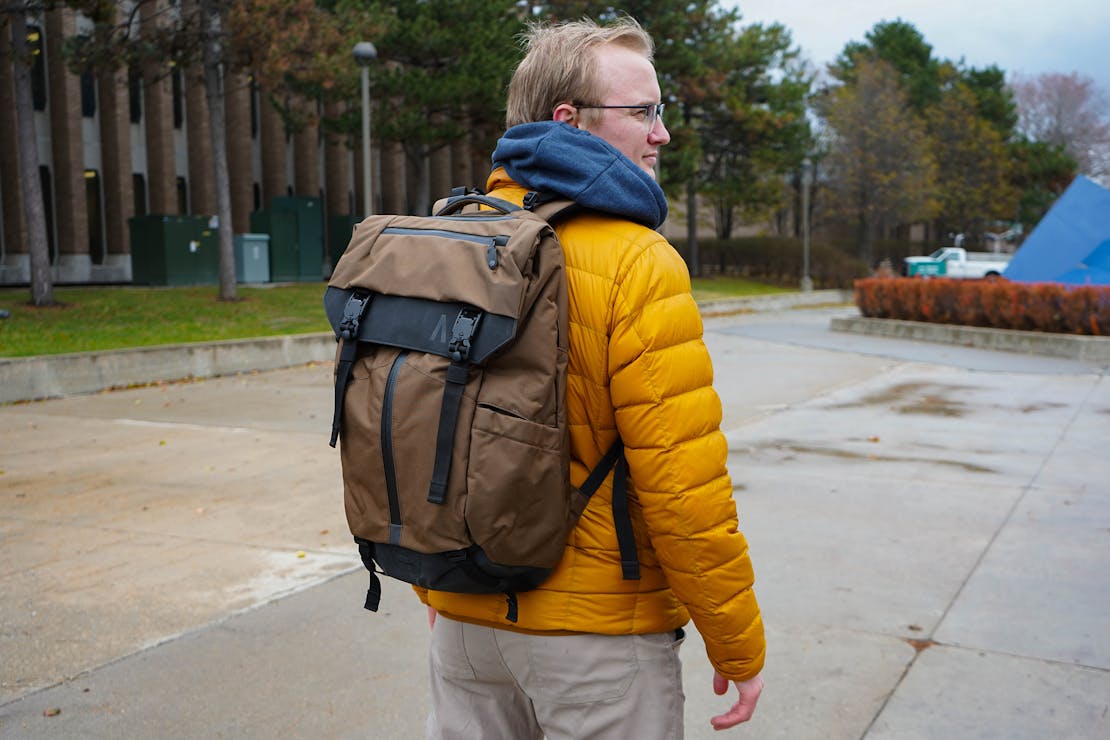
The Prima System includes a 30L travel backpack, the Fieldspace admin panel, and Verge Camera Case. The Fieldspace holds a tablet or small laptop, plus small accessories, docking to the laptop compartment with a magnet, so it’s removable if you don’t need it. The camera case is also fully customizable and can sit inside the pack, connect to its exterior, or be carried separately.
Organization: Multiple Travel-Focused Features or One Big Compartment?
Some backpacks take the approach of having a massive inner compartment with no organization. This is great if you’re planning on using some packing cubes or compression sacks, but not so great if you want a little more internal organization out of the box. More things to consider: is there a dedicated place to put a pen or two for those pesky customs forms? Is it easy to grab? How about a dedicated laptop compartment (or, for that matter, a dedicated laptop bag)?
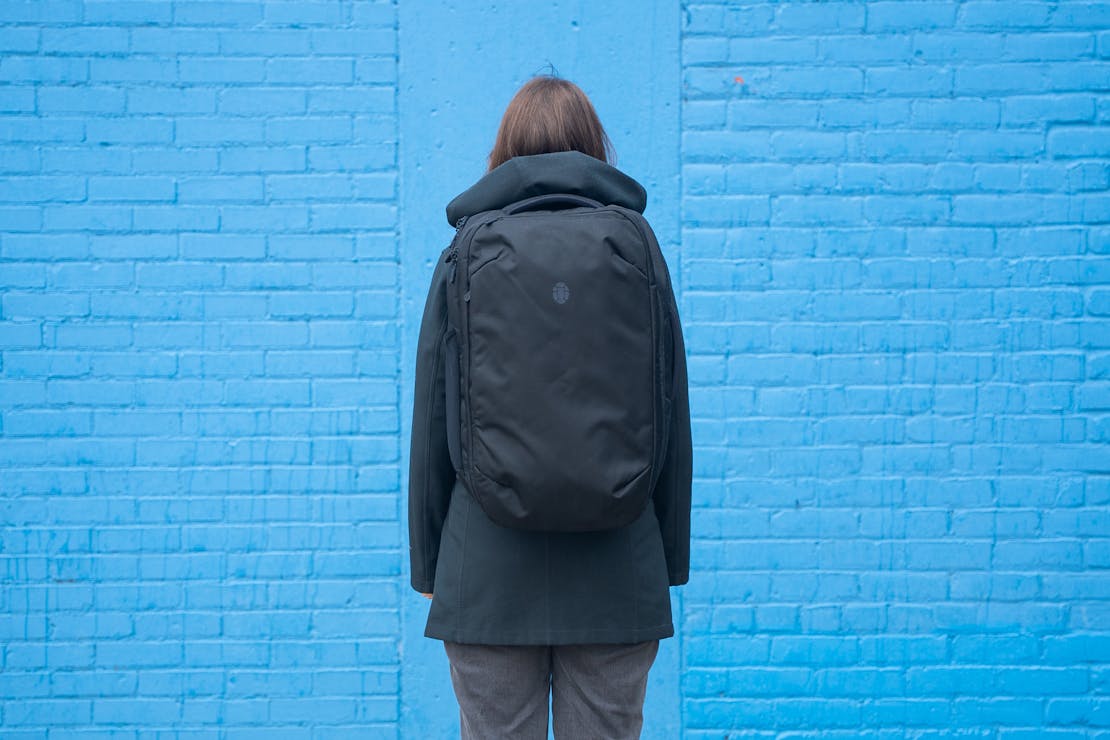
This iteration of Tortuga’s travel backpack design gives more control to the user. It has fewer organization options than its predecessors, but the extra space and weight savings can be better used for packing cubes and organizers. Those already invested in such accessories will find the wide and spacious main compartment easy to fill and navigate.
Packing Cubes
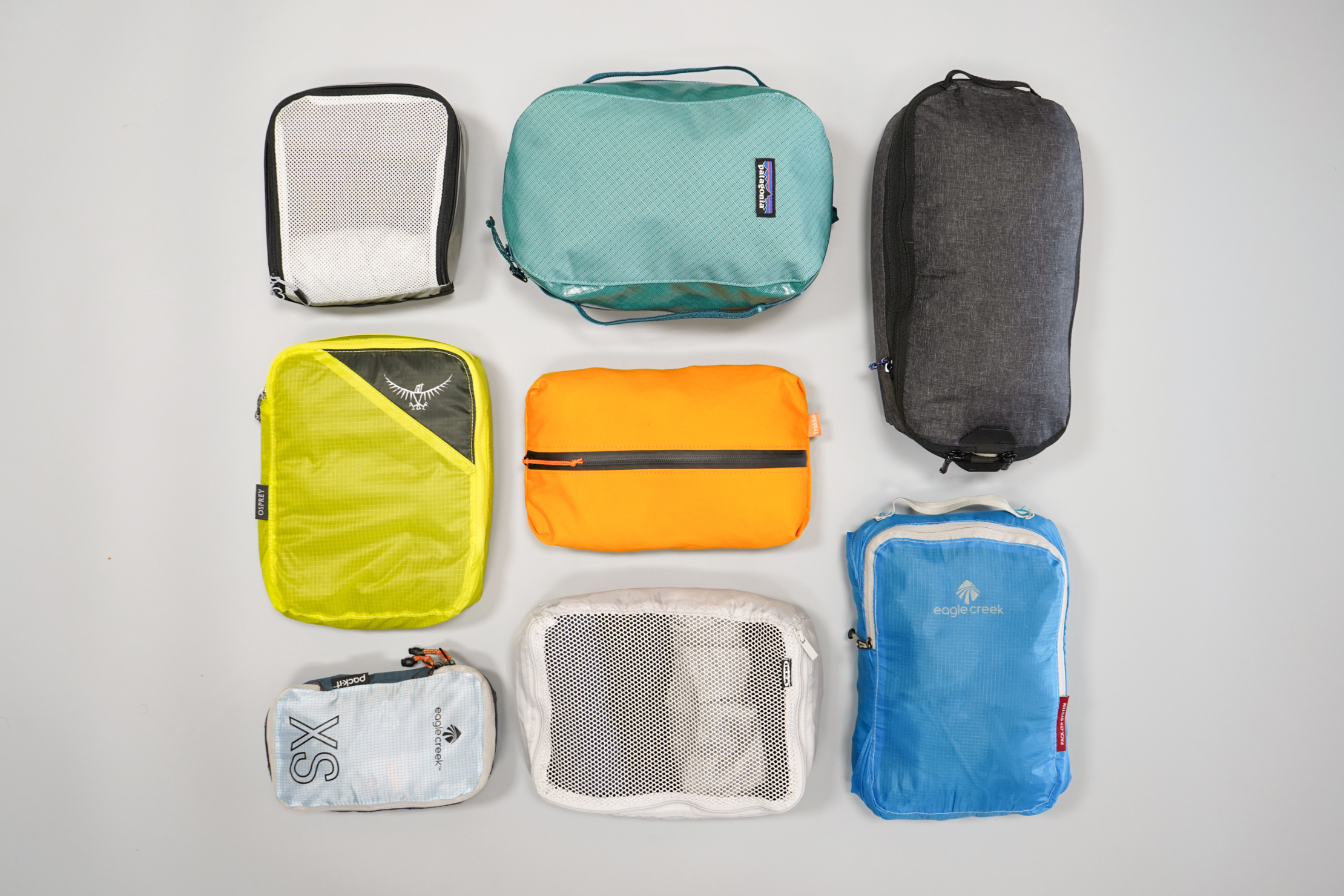
Packing cubes can be a great addition to your luggage regardless of whether the bag is one massive compartment or has a couple of smaller pockets inside. Packing cubes allow you to organize clothing between type, outfits, clean or dirty, and much more. Some even have compression zippers so you can save extra space in your bag.
Compression and Expandability
If you’re going with one bag, versatility is essential. Ideally, your pack will cater to different amounts of items that are packed in the bag.
Some packs even offer detachable daypacks, but they tend to be slightly larger in liters. For example, the Osprey Farpoint 55 Travel Pack is only 55 liters because you strap a 15-liter daypack to the main 40-liter bag. On the other hand, the Pakt Travel Backpack V2 has a dedicated compartment for their 15-liter daypack when it’s empty, and if you leave it behind, you can use that space for anything else you want.
If you’re looking for a small travel daypack, consider a packable backpack instead. There won’t be any significant padding, but you could pair it with a padded field pocket from GORUCK or a padded laptop sleeve if you want to cafe-hop and work for the day.
If you are looking for a more padded daypack, a Mystery Ranch In and Out Packable Daypack, or something like a Fjallraven Kanken 13″ Laptop Backpack could work. At the end of the day, you’re packing another set of straps, padding, and zippers—all space and weight that’s being subtracted from your main pack.
We like sticking to one bag whenever possible (or keeping it minimal with a sling), and there are some bags out there with the right size and look that can be used as a daypack and for one bag travel.
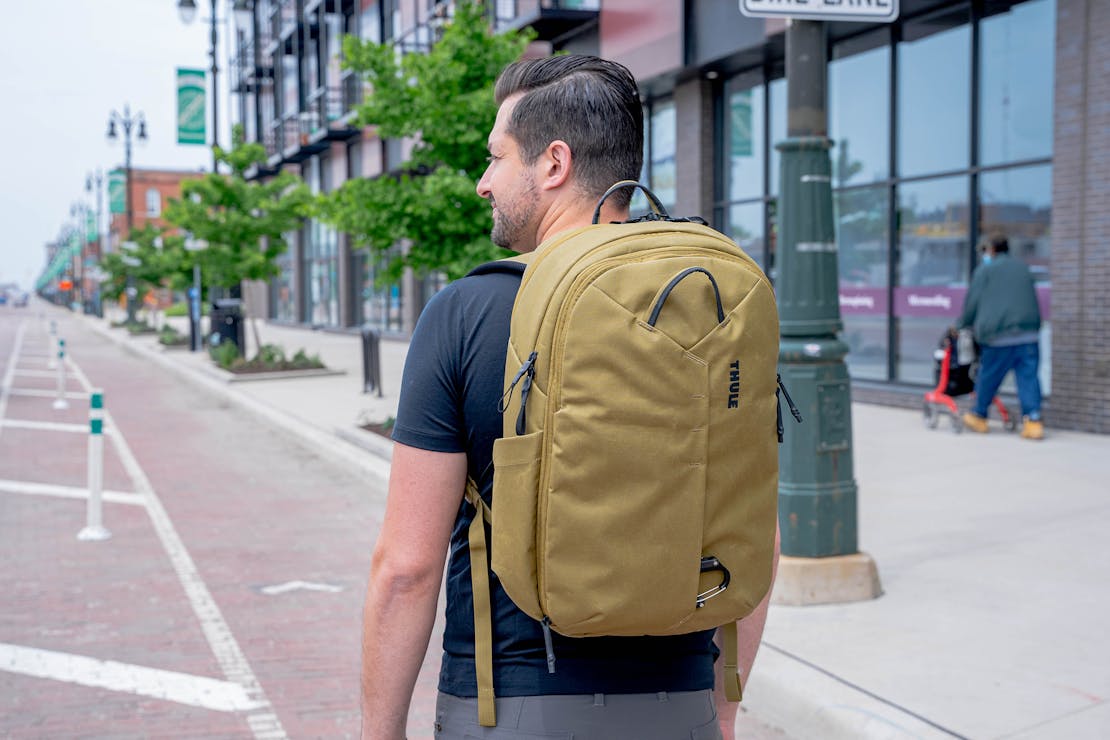
The Thule Aion 28L Backpack expands to 32L when you need more space for a trip without looking oversized. Use the extra room when you’re traveling, then empty it and compress it back down when you arrive at your destination to have a slimmer bag that can be used as a daypack while walking around.
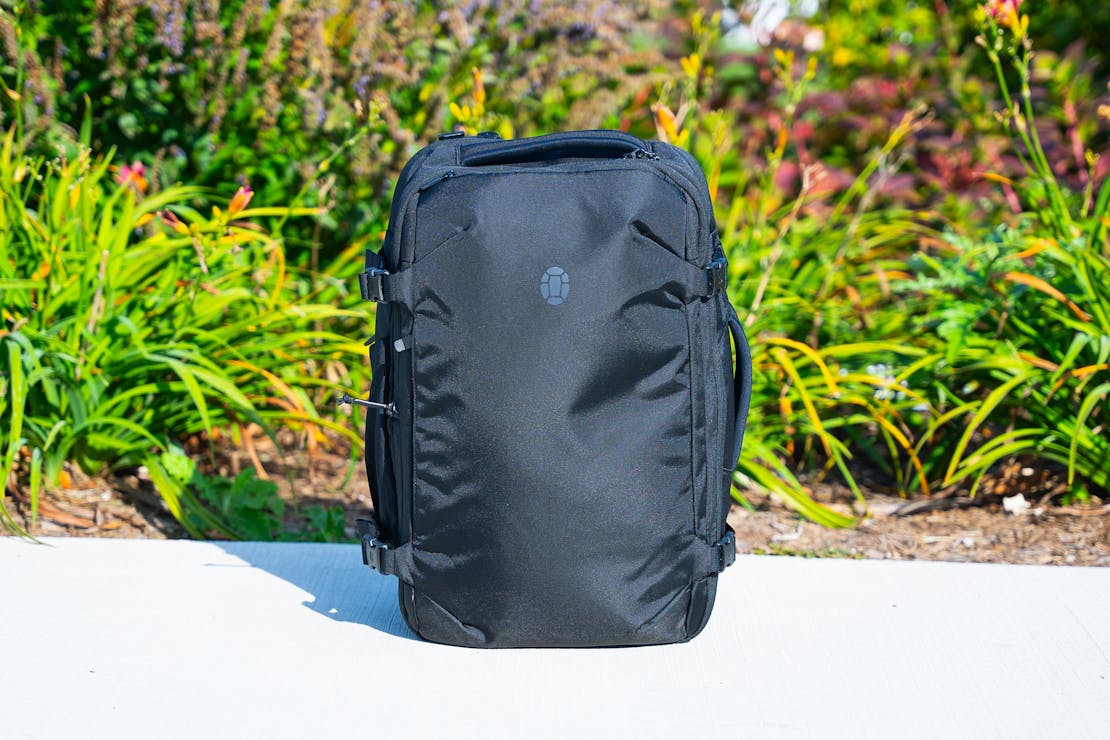
While the Tortuga Expandable Backpack has enough capacity for one-bag travel at its baseline, you get an extra 5.5 liters of space when you open the expansion zipper. We think it’s a bit too large to pass as a daypack, though we dig the extra carry-on compliance the compressible profile provides.
Security Backpacks
Be on the lookout for packs with great security features. Are the zippers lockable with TSA-approved locks? Are there separate secret security compartments to place your passport and other valuables in hard-to-reach places? Is it made of a solid material to prevent the quick slash-and-grab? Are the outer pockets minimized to make it hard for a thief to unzip?
A lot of safety when traveling comes down to common sense and your own self-awareness, but there are a couple of pack features that can make your trips a little bit safer.
Lockable Zippers & Anti-Theft Backpacks
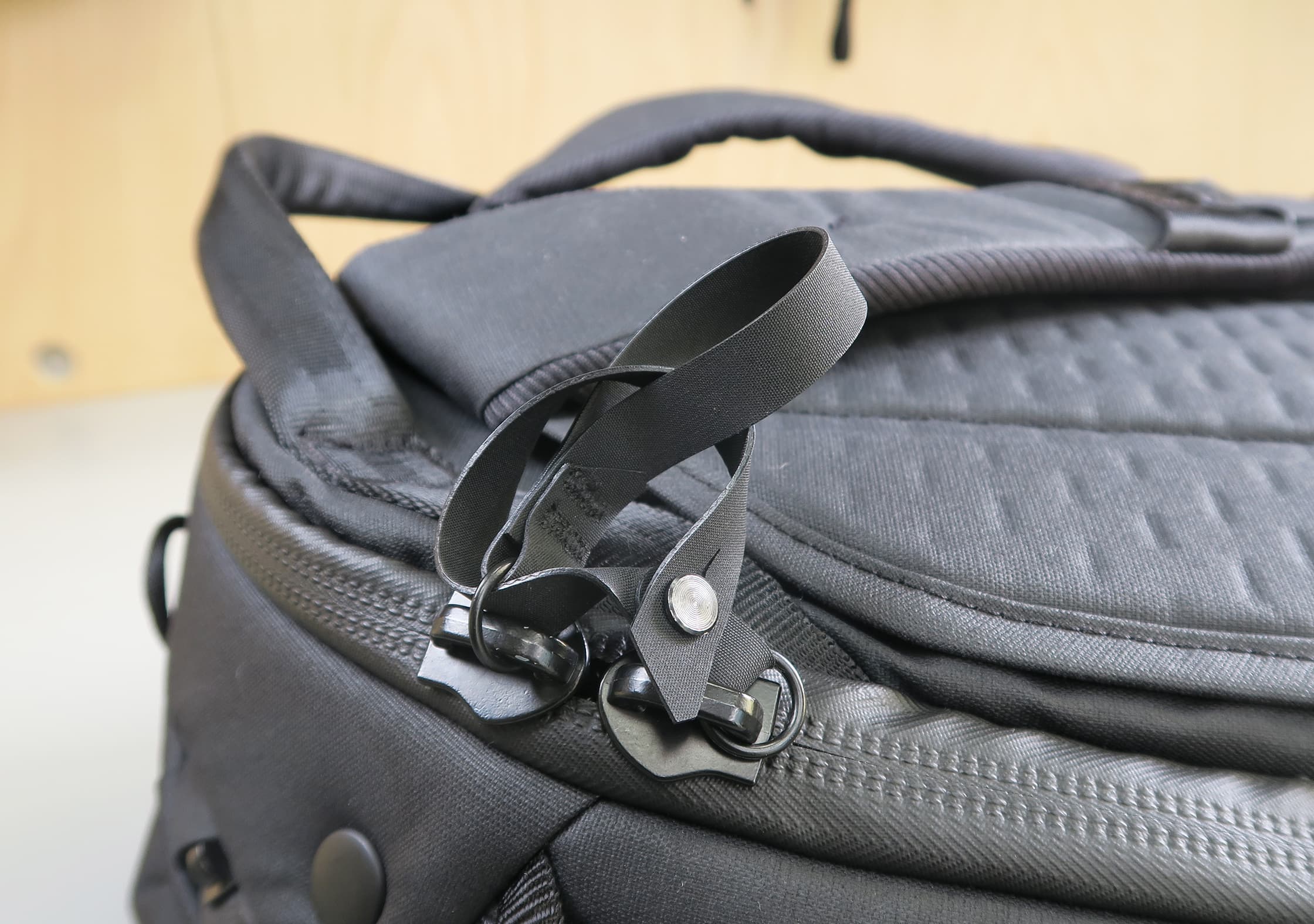
Some packs offer lockable zippers or special looped zipper pulls that can be configured to deter thieves. Locking the zippers on your pack won’t turn it into an anti-theft backpack—someone can still take it or cut through the fabric—but it can help stop wrongdoers from quickly unzipping your bag for a quick-grab, or make them move to the next easily accessible bag on a train or bus. No backpack is impenetrable, though, and some of these features on backpacks can be gimmicky—included just so the purchaser has some peace of mind—even if the benefit isn’t that great. WANDRD’s security features (example below) and PacSafe’s anti-theft technology put a lot of emphasis on that extra layer of security.
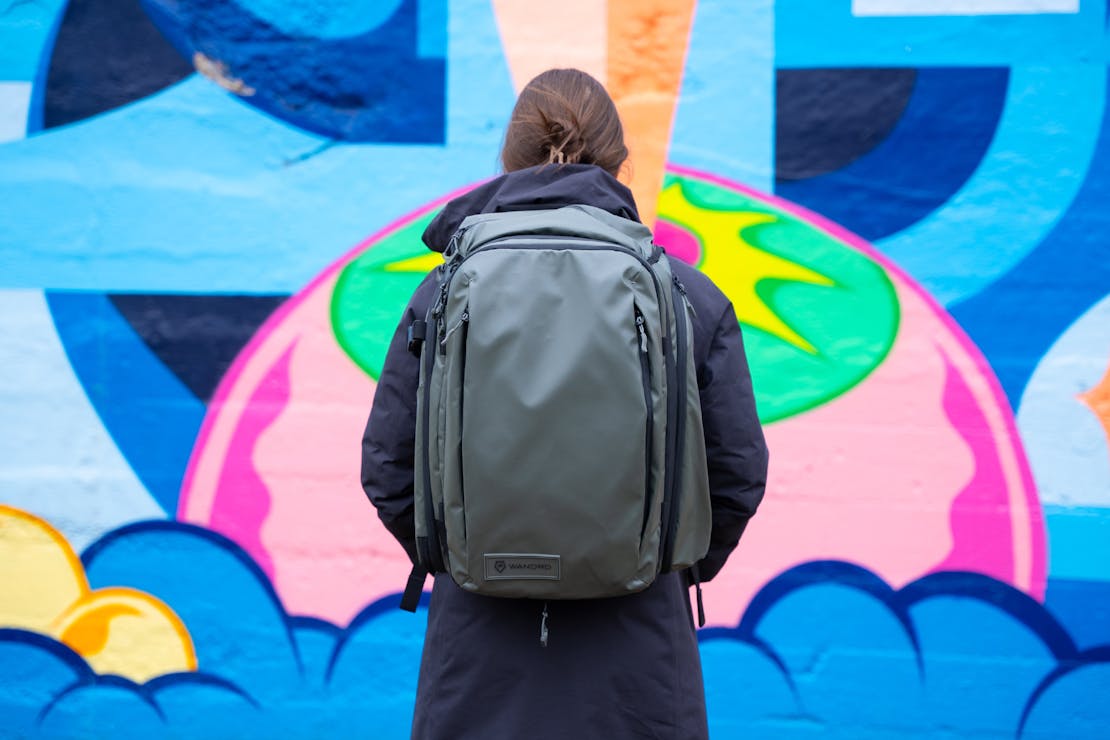
The zippers on the WANDRD TRANSIT Travel Backpack’s zipper pulls easily lock together using a twisting design. This won’t necessarily deter all theft, but it’ll stop anyone from the old unzip & grab trick, and it won’t be against TSA Guidelines.
Anti-Theft Backpack Materials
Some bags offer more robust fabric that naturally enforces the bag. As we mentioned before, materials like Ballistic Nylon, CORDURA®, and others are super helpful with this. Some companies even include special mesh wiring, like Pacsafe’s eXomesh®, that almost theft-proofs your backpack, allowing you to lock it to a fixed object for added security. EXomesh® is either lined inside the fabric or can also be purchased externally with other backpacks.
For the type of traveling we do, we think this is a little paranoid and adds some weight plus another thing to carry. However, depending on your situation, it could be helpful in countries with notoriously high pickpocket rates. Strolling through Tokyo? Probably not necessary. Heading to Rome for the first time? Yeah, we’ll take that extra layer of security.
RFID Blockers (Identity Theft-Proof Backpacks)
We feel that having a bunch of RFID-blocking tech covering an entire backpack is overkill. Sure, it’ll stop folks from electronically scanning your passport, but let’s face it—it’s much less effort for a thief to physically grab what they want from you. However, if it’ll help you sleep at night, you could get a special RFID wallet or wrap your passport & cards in aluminum foil. Some bags even have RFID-safe pockets tucked inside an admin panel where you can store your passport during transit. If it’s a 100% secure backpack you seek, we’re not going to stop you.
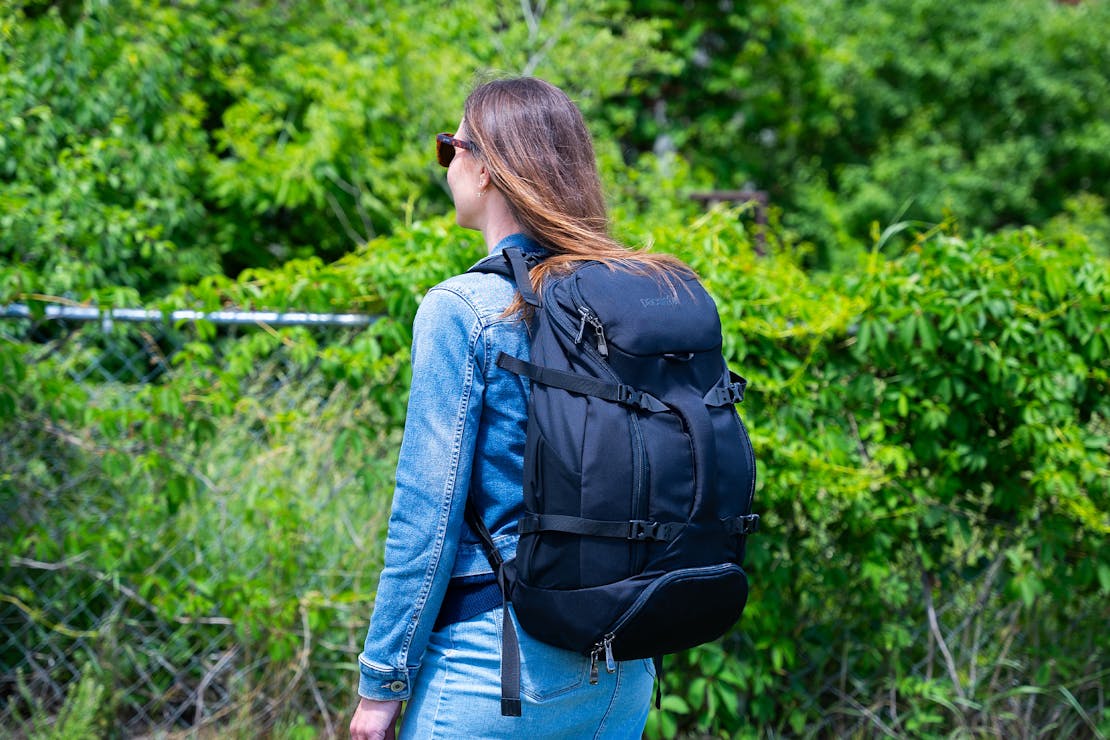
As far as secure travel packs are concerned, the Pacsafe Venturesafe EXP35 offers some great features for exactly that. From the eXomesh® slash-proof material to the secure zippers and RFID secure pockets, there is some great thinking that went into this pack along with some solid materials.
You know what they say—“It’s not how you feel, it’s how you look.” Or something like that...
We’ve teamed up with CabinZero to give away a selection of top travel gear! Check it out →
Video Guide Part 4: Aesthetic
Feel free to watch this guide section in video format. We’ll keep the written content on this page up to date.
Be sure to subscribe to Pack Hacker on YouTube and never miss a video. We also have these videos in a series playlist format on YouTube so you can watch them easier.
Finding the Best Travel Backpack Style For You
At the end of the day, the look and feel of a travel backpack should be right for you and your tastes, and there are many things to think about as far as aesthetics go. Stylish “urban travel” backpacks became a lot more popular within the last couple of years, and that’s the look we prefer. Gone are the days of international travel with a big blaze-orange hiking backpack. Those certainly have a utility, but that utility is in the wilderness. Here are a couple of overall style points for your consideration:
Minimalist Travel Backpacks
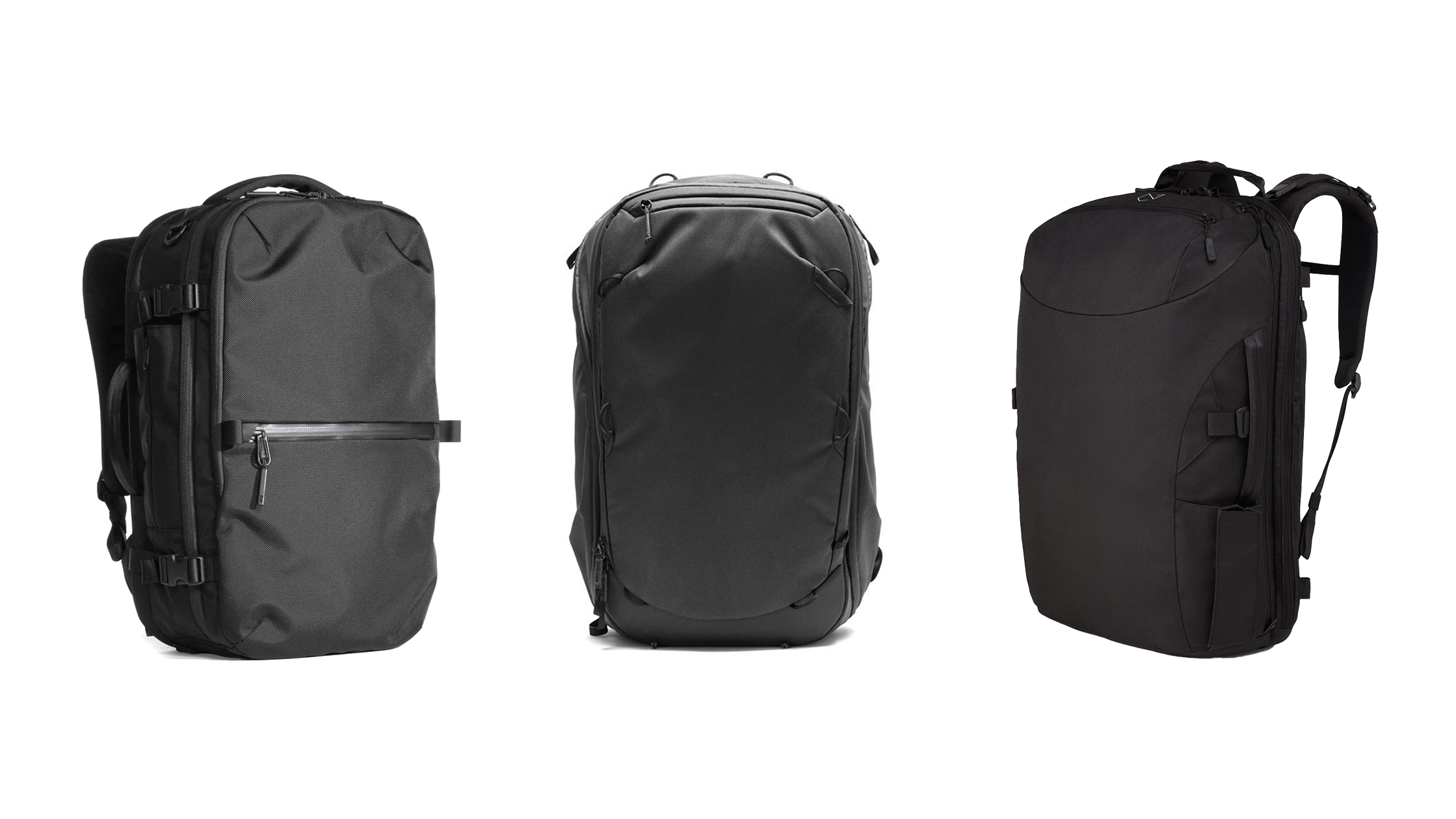
When you’re in a new country, think a bit about how you want to be perceived. If you’re heading to a more crowded or dicey area, nothing screams tourist like having a large, colorful backpack while looking up at tall buildings or a landmark in awe. It’s easier to keep a low profile and blend in a little if you’re not carrying around a monstrosity of a bag that acts as an advertisement for thieves and wrongdoers looking to target travelers for their own gain. It’s an added bonus if you can roll into a meeting wearing one of these things. As one-bag travel has become increasingly popular in recent years, we’re seeing many solid urban packs coming out that are built specifically with one-bag travel in mind.
Tacticool Backpacks
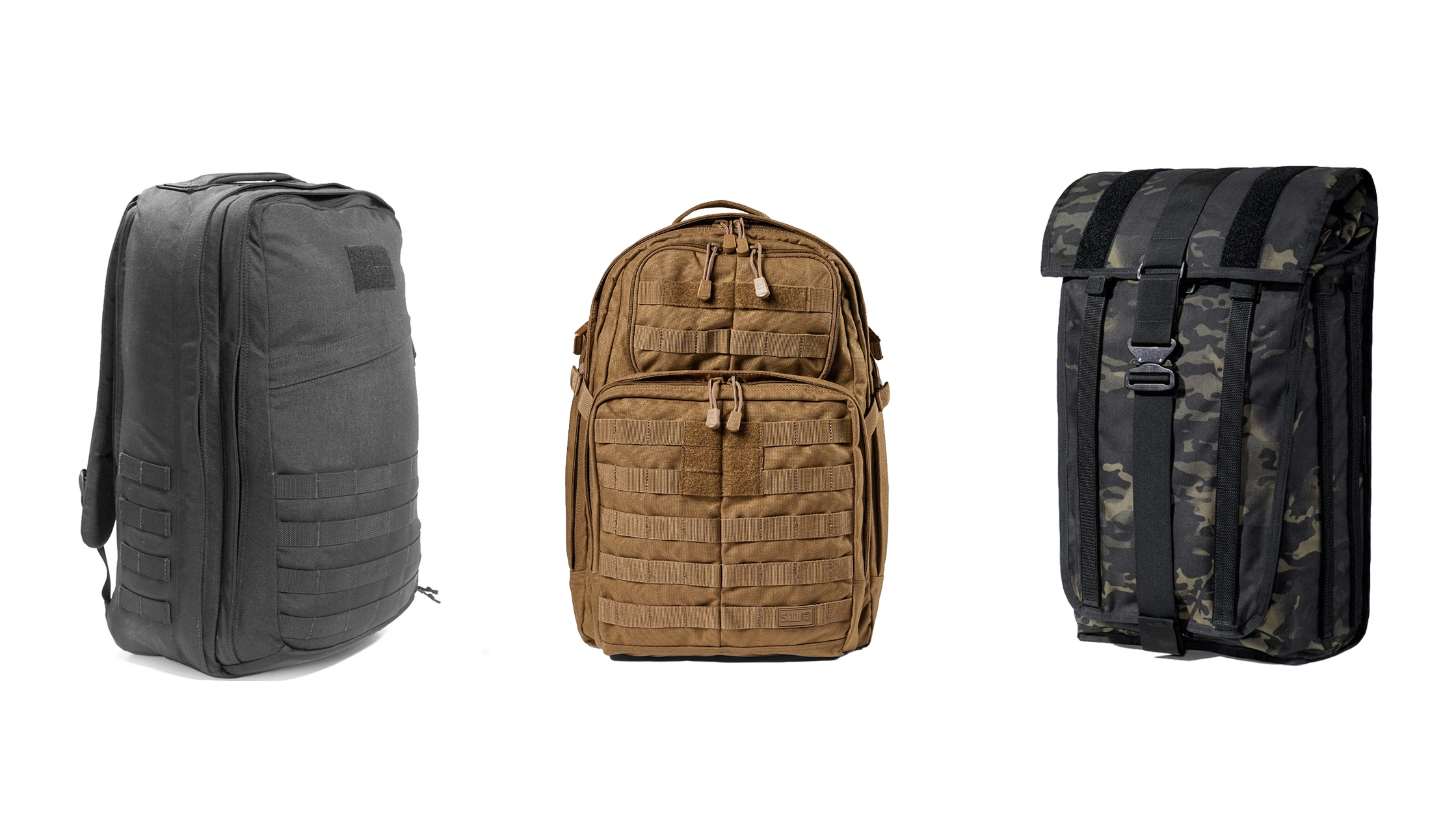
There are a ton of high-quality bags out there made to military spec. They feature great utility, like MOLLE for customizing your pack with accessories and stronger materials for increased durability. Keep in mind that some folks may perceive you as being in the military if your bag has too much going on. It’s one thing if the pack is all black & subdued, but another if it’s camo and filled with patches. If this is your look, go for it, but this type of pack might also bring about some “unwanted attention” in certain parts of the world.
Outdoor & Hiking Backpacks
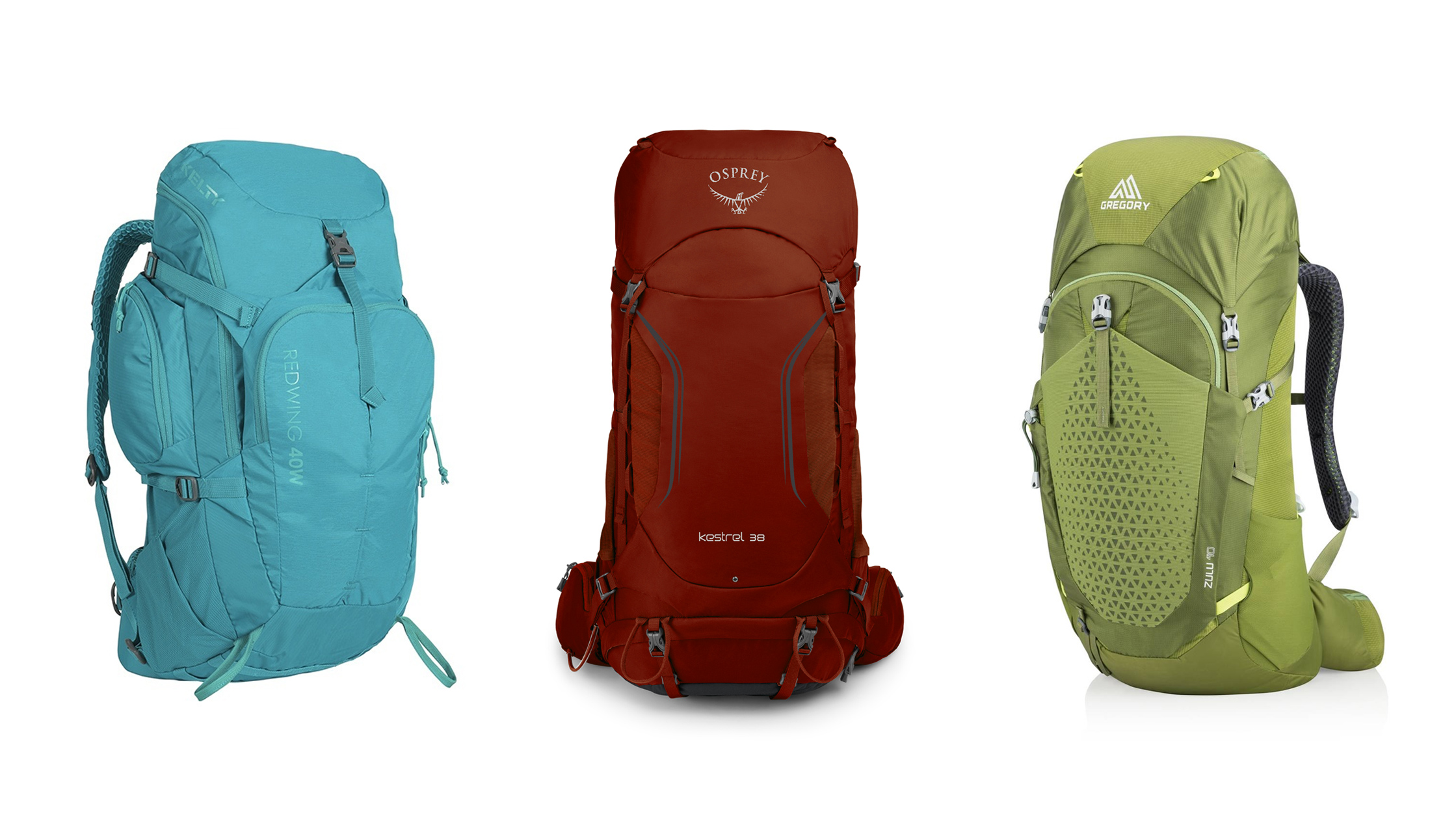
Think sportier packs with lots of pockets, brighter colors, and louder material. For a long time, outdoor backpacks were the only option for long-term one-bag travelers. They tend to be bulky and are built to carry big, heavy loads over long distances. This typically means lots of straps and a tall pack that will peek up over your head. Great for an extended camping excursion, not so great for a trip through the airport or a newly-discovered city square. They also tend to scream “TOURIST.” No one casually walks around with a giant hiking backpack.
Backpacker Backpacks
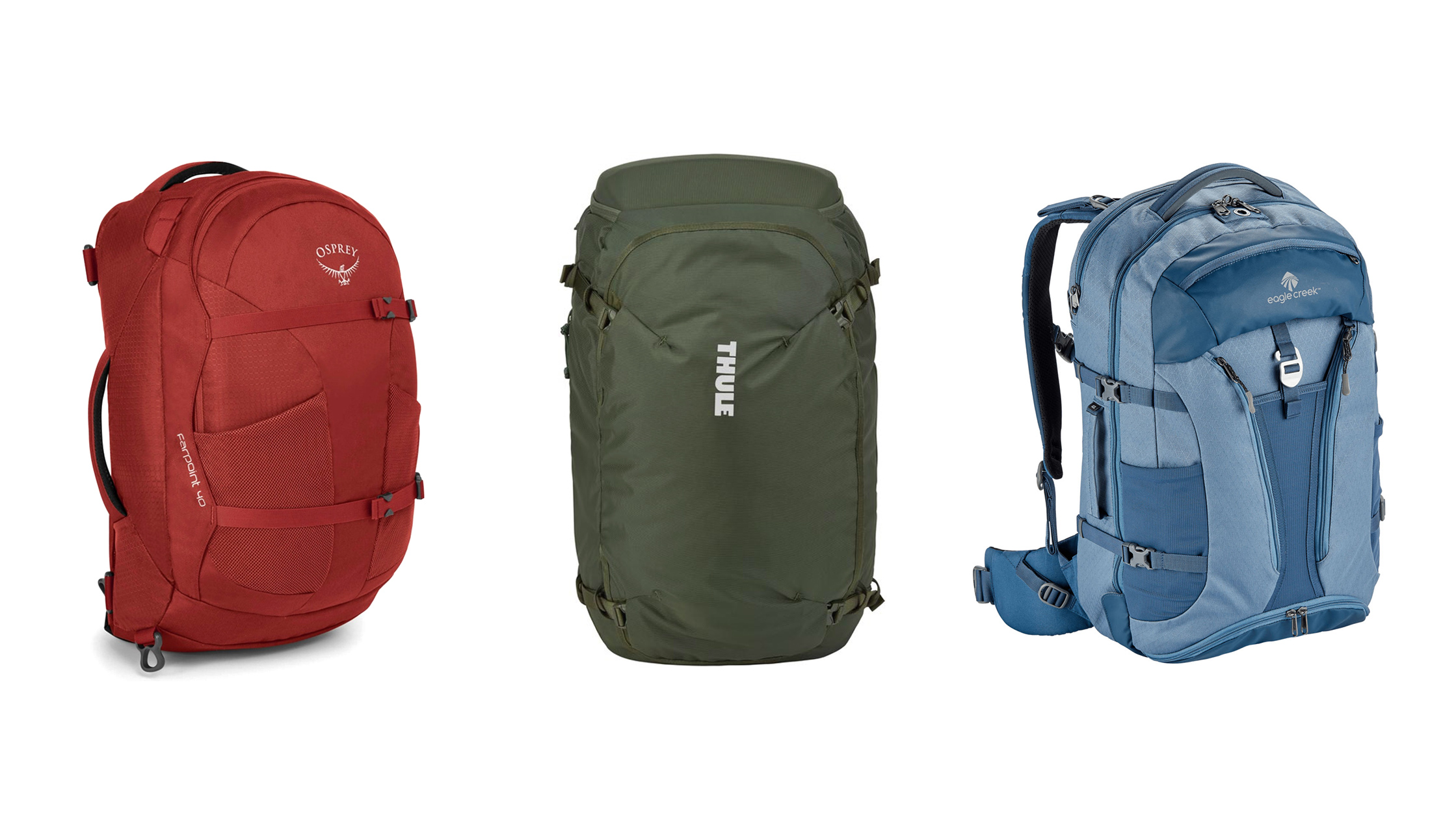
If it’s not already obvious, the “Backpacker Backpack” is designed specifically for backpacking around the world. Typically from manufacturers that also make outdoor and hiking backpacks, this is the go-to style for anyone on a gap year looking to tick off as many countries in Southeast Asia as possible. And because of that, they’re some of the most popular bags on the market today. Sure, you’ll still look like a tourist—albeit not as much as you would wearing a hiking backpack—but that’s fine because that’s exactly what you’re doing.
Heritage Backpacks
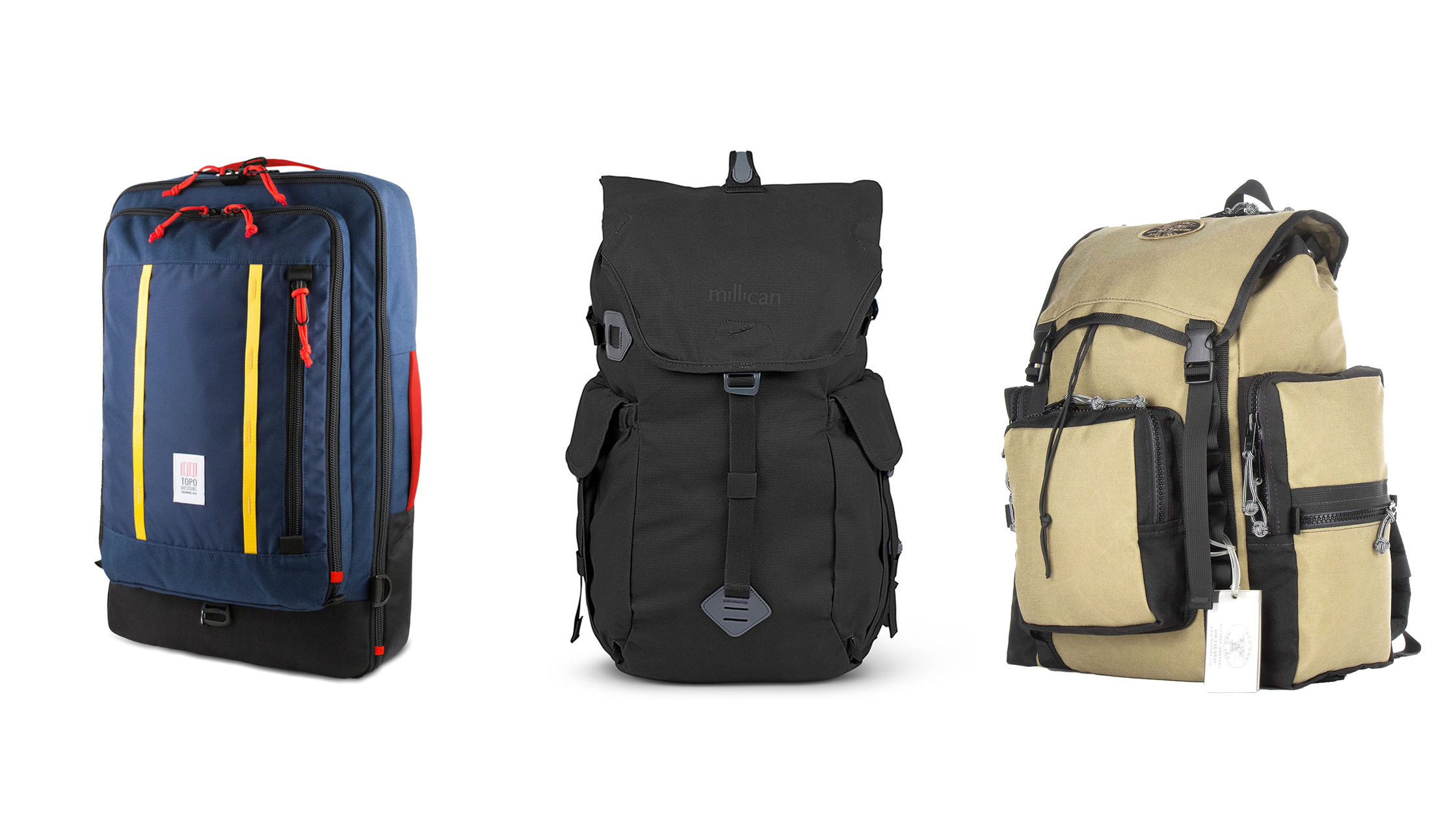
These bags are engineered with a classic look in mind. Most will be some variation of the one-compartment style with leather straps, subdued colors, and some type of canvas-y material. These packs look great but can sometimes lack functionality and comfort. Although there are a few bespoke-style travel bags, most will fall into the daypack category.
Having said all of this, aesthetic is subjective, and beauty remains in the eye of the beholder. This is why we conduct weekly polls over on our Instagram to get our communities’ take on the look of bags. Follow us on Instagram to cast your votes! You can find all the results of the polls on our individual review pages too, so you can see how well a bag you’re looking for has performed.
The humble backpack: It’ll get you through anything and everything...
We’ve teamed up with CabinZero to give away a selection of top travel gear! Check it out →
There Really is No “Best Travel Backpack”
Although, there is a best travel backpack for you. All this boils down to your preferences.
When we first started reviewing bags, we admittedly thought there would be one best bag for travel, but the deeper we dug, the more we realized it depends on your needs as an individual traveler. Sure, there are generally guiding principles to follow, and a bag made out of cardboard objectively won’t last, but there are too many quality backpacks out there to pick just one. If you’re on a short trip, a lighter, less durable pack will suit you well. If you’re headed to Southeast Asia during the monsoon season, you may want some heavy-duty weatherproofing.
We wish you the best of luck moving forward with your selection. Still want more? Be sure to check out our other guides and travel gear reviews too!
Our team at Pack Hacker developed the “best travel backpack” guide in partnership with our friends (and bag experts) at Carryology. We’re constantly updating this guide as new backpacks are released, and the travel landscape changes.
